
Are you ready to double your search traffic?
Understanding SEO is crucial to significantly increase your traffic and brand awareness.
Right now, thousands of people are looking for content just like yours. You can help them find it by becoming an SEO expert.
In fact, 40 percent of website traffic begins with a search query. That’s why search engine optimization (SEO) is so important.
Staying on top of SEO takes a lot of research and experimentation. Google’s algorithms are constantly updated, so it’s important to stay tuned into the latest news. With a bit of practice, you can become your own SEO expert.
That’s what I did!
Every day, people use Google to conduct over 3.5 billion searches. In the U.S., 78% of people use the web to research products and services before buying.
Once your website begins to rank on the first pages of Google’s search results, you’ll get more visibility. This means more traffic, more conversions, and eventually, increased revenue.
Getting to page one of the search results is vital. 75% of users don’t even click past the first page!
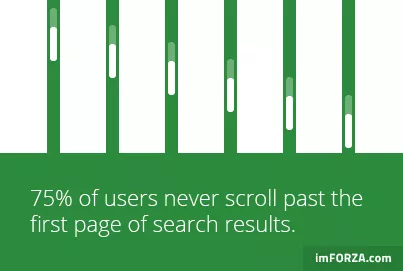
The first three organic search results get 60% of all traffic from a web search. Leads coming from a search have a 14.6% close rate, compared to just 1.7% from channels like print or direct mail advertising.
See why SEO is so important to your success?
Here are 19 advanced SEO techniques that you can implement right away to increase your search traffic. Getting more visitors should help you convert more people into customers too.
There’s more that goes into conversion optimization than just getting traffic, like making sure you have a clear lead capture form, a sales page, and descriptive product pages.
But you can’t sell to people who aren’t there, right?
So let’s get started!
Advanced SEO Tip 1. Complete An SEO Audit On Your Webiste
Auditing your website helps you figure out why you’re not getting enough search traffic and sales. Many SEO companies offer this service, but you can save a lot of money by doing it yourself.
In general terms, an audit is a systematic examination of an event, a concept, or financial books that is done in order to figure out where you stand and how to make smarter decisions in the future.
In the SEO world, auditing is a growth hacking technique that will help you attract and retain customers.
An SEO audit closely examines your overall site performance, creates goals based on what you find, and implements tactics to reach those goals. This process helps increase profits by making the best use of the content you already have and fixing any SEO issues.
This may not sound like an advanced SEO strategy, but you’d be surprised how many websites are missing basic on-page SEO like page titles or descriptions. It’s easy to overlook when creating your website, but easy to fix with an audit.
Here’s what you should be looking for during an audit:
Check #1: Do all your website’s pages have SEO meta titles and descriptions?
Check #2: Is each page on your website optimized for SEO keywords?
Remember, optimize appropriately without keyword stuffing!
Check #3: Is your URL structure optimized for search engines?
Your URLs should be simple, short, and easy for a search engine to tell what the page is about. Here’s an example:
21 Bing Ads Hacks That’ll Increase Clicks While Decreasing Spend
I bet you can guess that article is about 21 ways to improve your Bing ads!
But what if the URL looked like this instead?
https://ift.tt/2mfBcbU
Seems a bit complicated, right? A search engine would have a tough time determining the topic of that post since the keywords are broken up by folders and dates. It’s not very clear.
When it comes to URLs, simple is better.

Check #4. Is each page and blog post formatted properly?
By properly, I mean is each page:
- Broken up with headings and subheadings (h1 and h2 tags)?
- Using two to three sentences per paragraph?
- Bolding or italicizing important points?
- Optimized with a call to action?
43% of people skim blog posts instead of reading the whole thing. Make it easy for people to read!
Check #5: Do all your images have keywords in their ALT tags?
Check #6: Are you using links in your content?
This includes both internal links (to your own content) and external links (to other websites).
I cover linking in detail later in this article, but it’s very important for SEO as one of Google’s top three ranking factors.
Now if you want to save some time, there’s an easier way to do a site audit. Here’s how to use Ubersuggest to conduct a site audit and discover opportunities for improving your search traffic:
Step #1: Use Ubersuggest
Go to Ubersuggest. Enter your website URL into the box, and press Search.

Step #2: View SEO Analyzer
You’ll be taken to a results page. Click SEO Analyzer. It’ll take a few minutes to crawl your site, but the results are worth it, I promise.
Step #3: Review Your On-Page SEO Score

This is your overall on-page SEO score for all pages scanned during the site audit. 0 is the lowest possible score and 100 is the highest. With a score of 84, my site is rated as “great.”
Step #4: Review the Health Check and Errors

There are four sections to review:
- Health check – Overall health of the pages of your website
- Critical errors – Issues that have the biggest impact on your SEO health
- Warnings – Less impactful issues that still deserve your attention
- Recommendations – Recommendations to consider, but don’t have much impact on your SEO health
Step #5: Check out Top SEO Issues

This is the final section of the site audit, and it outlines the top on-page SEO issues. You can click on each line for more information.
For example, “21 pages with duplicate meta descriptions.” Unique and engaging meta descriptions are critical to boosting the click-through rate from the search results to your website.
When you perform a full website SEO audit, you’ll likely find at least a few errors or suggestions for improvement. No one’s perfect!
Ubersuggest is a great SEO tool to monitor the performance of your website and blog posts.
Advanced SEO Tip 2. Learn What Your Users Want
Google isn’t an advertising company. They’re a big data company.
Every tool, platform, and device that they design has one purpose: to get data from users and use it to build a stronger search engine.
Think of yourself as a big data company.
You need to focus on what your target customers want. When you understand what they want, you can develop content that draws them in.
When you listen to feedback from your target customer, it guides the content you create to attract more of them.
The opinions of your users count. The public determines whose idea, article, product, or concept gets shared or funded.
Think about Kickstarter. Most campaigns languish unnoticed for days until a few people donate some money. Then, other people follow.

So, how do you get relevant data about your users’ interests?
And how do you get feedback from your ideal customer if you’re just starting out and don’t have any real customers to ask?
There are several ways to find out:
- Use social media platforms like Quora
- See your most popular pages in Google Analytics
- See what posts get the most shares
- Listen to visitor comments on your blog posts
Let’s cover the first one: social media platforms.
Ask yourself, “Where do the people I want to attract hang out online, and what topics do they talk about?”
I personally like to use Quora.
It gives me an idea of what my target audience is talking about and I can learn from experts in the process. If I wanted to write a book or course, the things people ask on Quora would be useful sources for content ideas.
Here’s how to find out what people want using Quora:
Step #1: Go To Quora
You’ll need to sign up for an account, or sign in with Google or Facebook to get in.

Once you’re logged in, type in your primary keyword (e.g. blog traffic) and hit enter.

Step #2: See What Questions People Ask
If you know how to answer one of these questions, write a blog post about it.
You already know that people want to learn about that subject. If one person asked it on Quora, chances are there are hundreds of other people wondering the exact same thing.

Step #3: Get Ideas From Experts
Quora is a great place to learn new things. When it comes to advanced SEO, you can never know everything so I visit it frequently to learn from others.
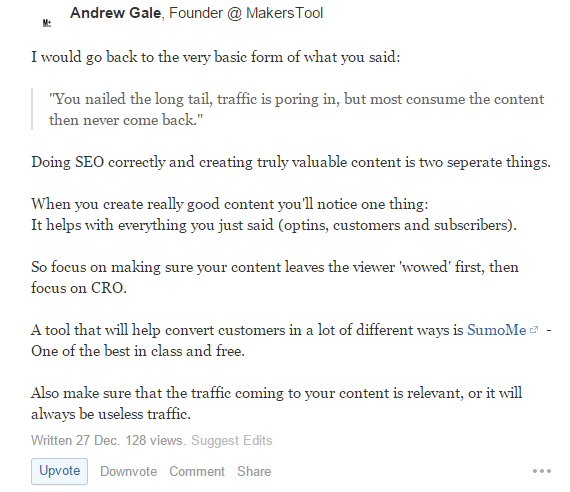
There are currently 16 different answers to this question. The above screenshot is just one of them, but you can imagine how much high-quality content you could create from this one answer alone.
Use these answers to form the outline for your next blog post.
How to Use Google Analytics to Find Out What Readers Want
You can also use Google Analytics to find out what your readers want.
Step #1: Login to Google Analytics. On the left-side menu, click on Behavior -> Site Content -> All Pages.
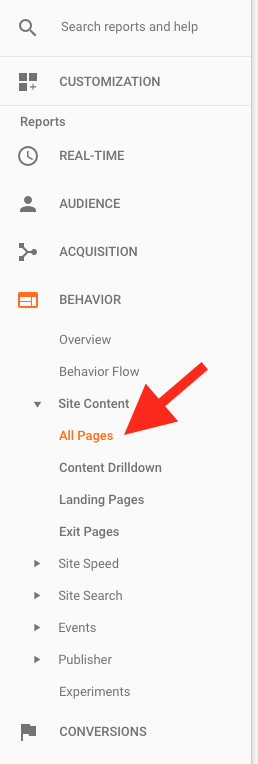
Step #2: Look at what your most popular pages and posts are.
The total number of page views is important, but also take a look at the average time spent on the page (the higher the better!), the bounce rate, and the exit percentage.
Here are my top pages from May 14th to June 14th 2017:
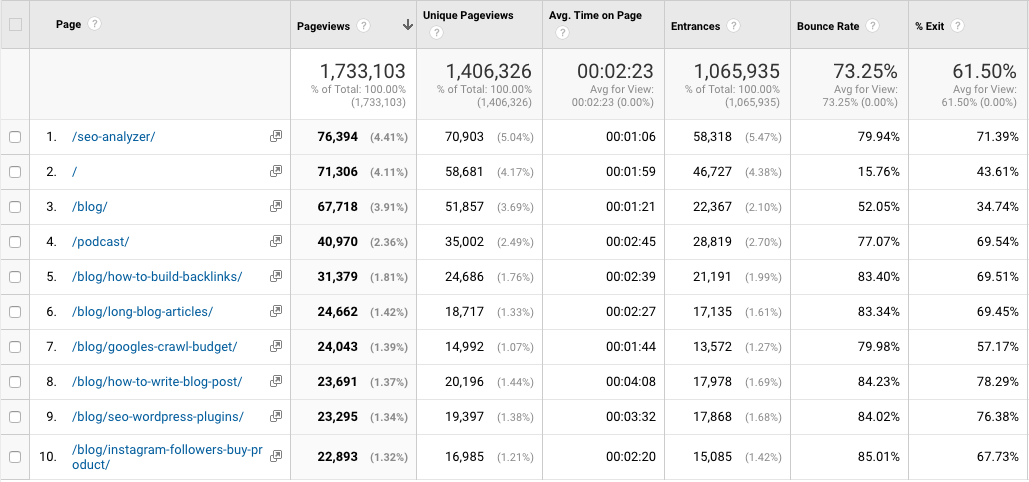
The average time spent on the page tells you if people actually took the time to read your full post, or just skimmed it.
Anything under a minute should be a sign that people are quickly skimming and not reading your article?
So if I see an average time of thirty seconds, I’ll know that people didn’t find my post that interesting to stick around for long.
The bounce rate tells you the percentage of people who landed on this page, but then left without visiting any other pages. It’s not an indicator of success or failure by itself, but ideally you want people to stick around and check out at least 2-3 pages.
The exit percentage tells you that for this page specifically, x % of users left your site after visiting this page. Like the bounce rate, it’s not an indicator of a problem by itself, but if your exit rate is 99%, well, that probably means users aren’t finding what they want to know on that page and don’t want to explore any further.
Another great way to find out what people want is to see how many times your content gets shared on social media.
BuzzSumo is a great tool for this. Just enter your website URL and hit Go.
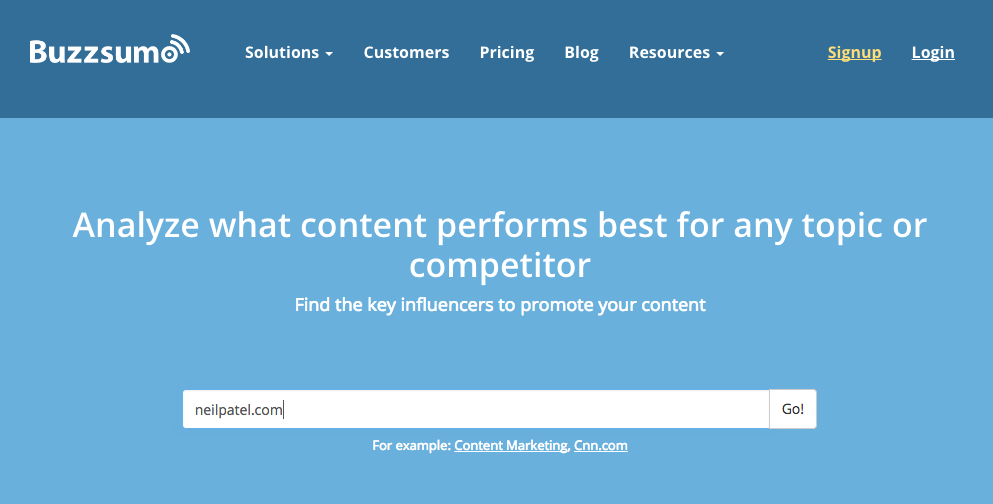
It will give you a list of your most popular content, sorted by the highest share counts.
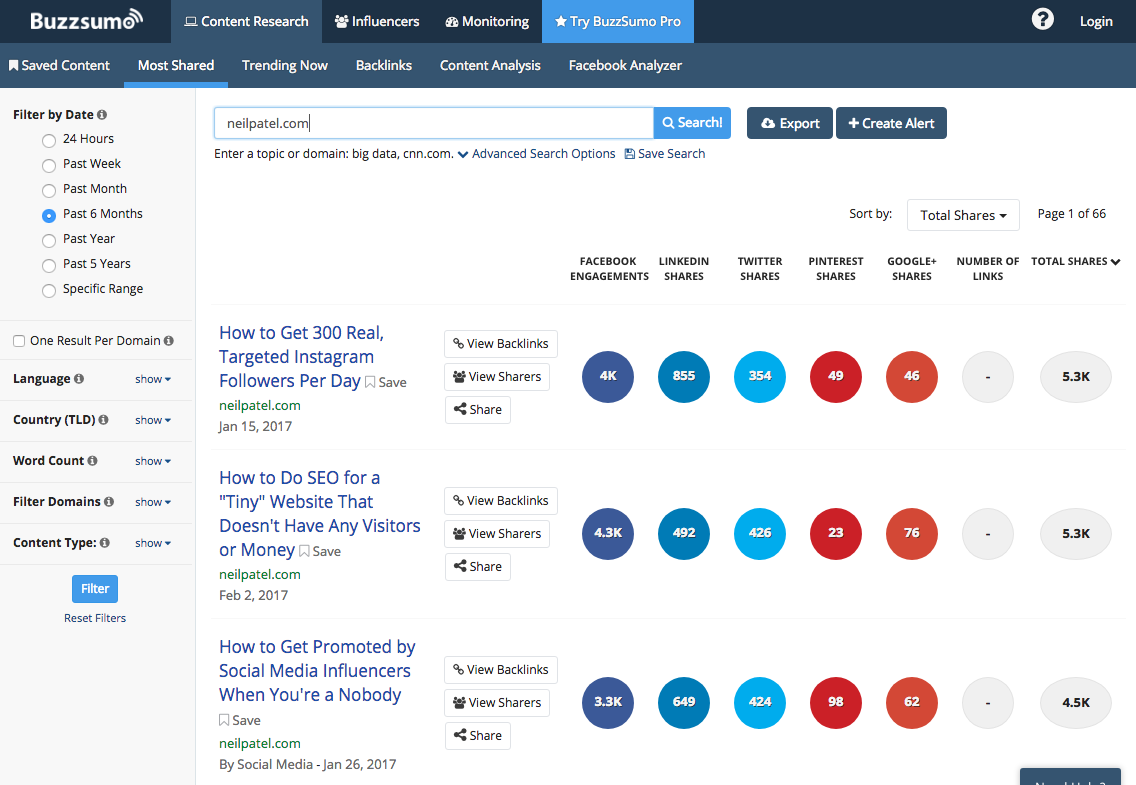
This lets you know which articles people love enough to share. The most common reason people share content is when they think it will be useful to others.
With that being said, the total number of shares your post gets is a good way to tell if people find your content useful.
You want to know the easiest way to find out what your users think? Just read their comments on your posts.
When you answer real user questions with your content, your search traffic will improve dramatically.
Advanced SEO Tip 3. Create SEO Optimized Landing Pages
A well-designed landing page can improve your lead generation and sales. The more landing pages you create, the more gateways you open up for incoming search traffic.
Unfortunately, not many B2B companies fully grasp the importance of using specific landing pages to capture new users.
According to the SEO research firm, MarketingSherpa, 44% of clicks for B2B companies go to a homepage, not a landing page. Sure, the homepage is important, but a landing page is where you can initiate a strong relationship.
Here’s an example.
Copyblogger creates high-quality landing pages on popular topics. They go the extra mile with professional graphics and a clean, modern layout.
Then they drive traffic to the landing page through press releases, email marketing, and SEO optimization.
Here’s one of their landing pages about, well, landing pages.

As you scroll down, you learn more about landing pages:
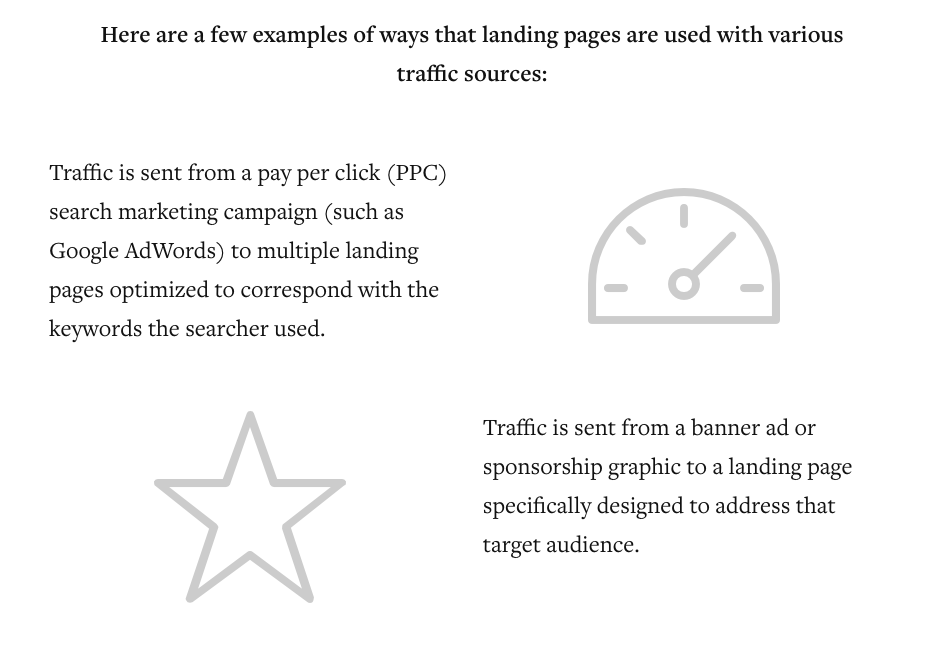
The key elements of a good landing page are:
- No navigation (you want users to stay on the page!)
- Useful, informative content
- A call to action (to sign up for your product, service, download a lead magnet, or another type of action)
On Copyblogger’s page, they have useful content with links to relevant articles:
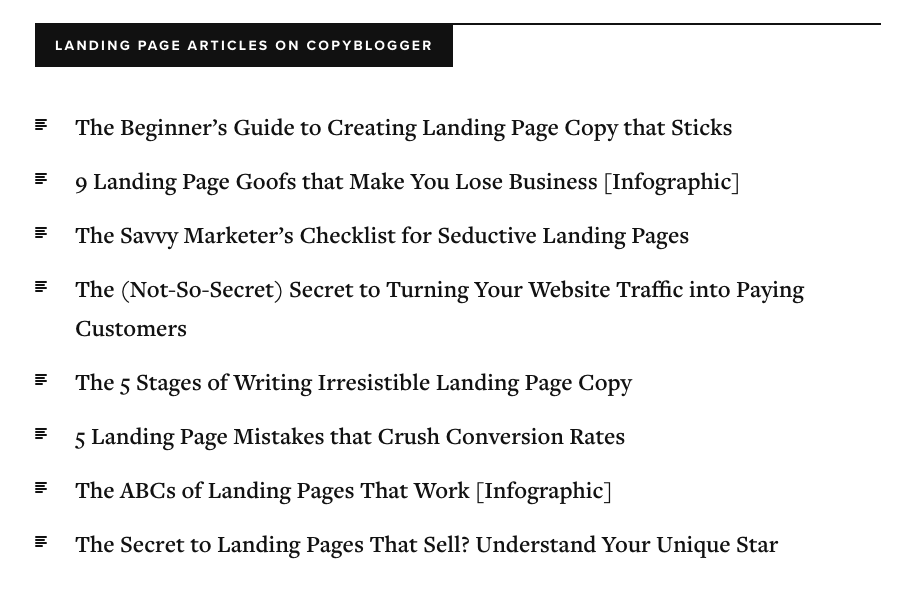
And, a noticeable and clear call to action:

Do you think these landing pages have good SEO value?
Do people actually link to them and share them on social media?
Let’s find out.
Go to Ahrefs.com. Enter a landing page URL — let’s use http://www.copyblogger.com/copywriting-101/ — and click Search Links.
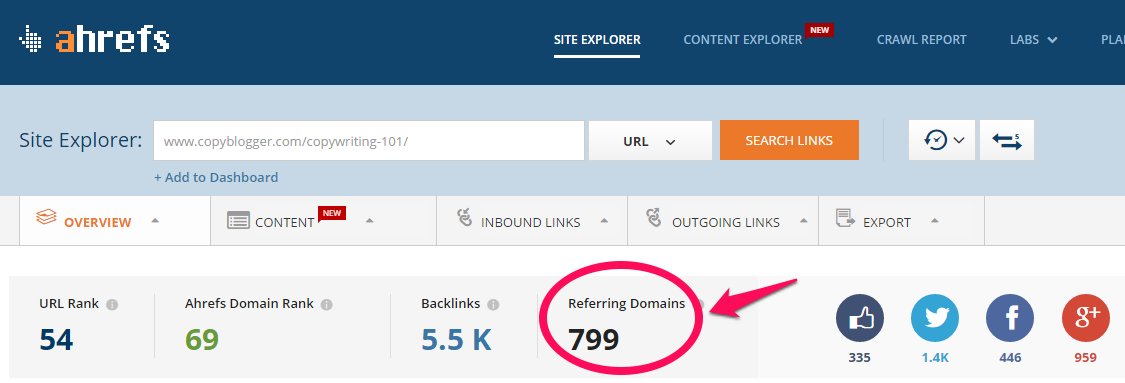
As you can see from the screenshot above, this landing page has 799 trusted inbound links, over 1,000 tweets and 446 Facebook likes. This landing page is clearly doing its job of converting visitors into leads.
Landing pages can generate a lot of income.
Conversion Rate Experts made $1 million for Moz, using a single optimized landing page and a few emails.
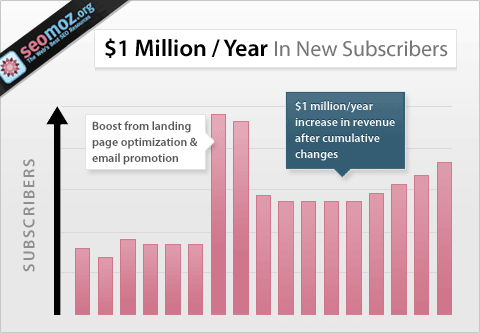
Businesses with 10-15 landing pages see 55% more conversions than those with less than 10 landing pages.
Businesses with over 40 landing pages have 500% more conversions!
Basecamp has a great landing page to sign up for a free trial of their product.
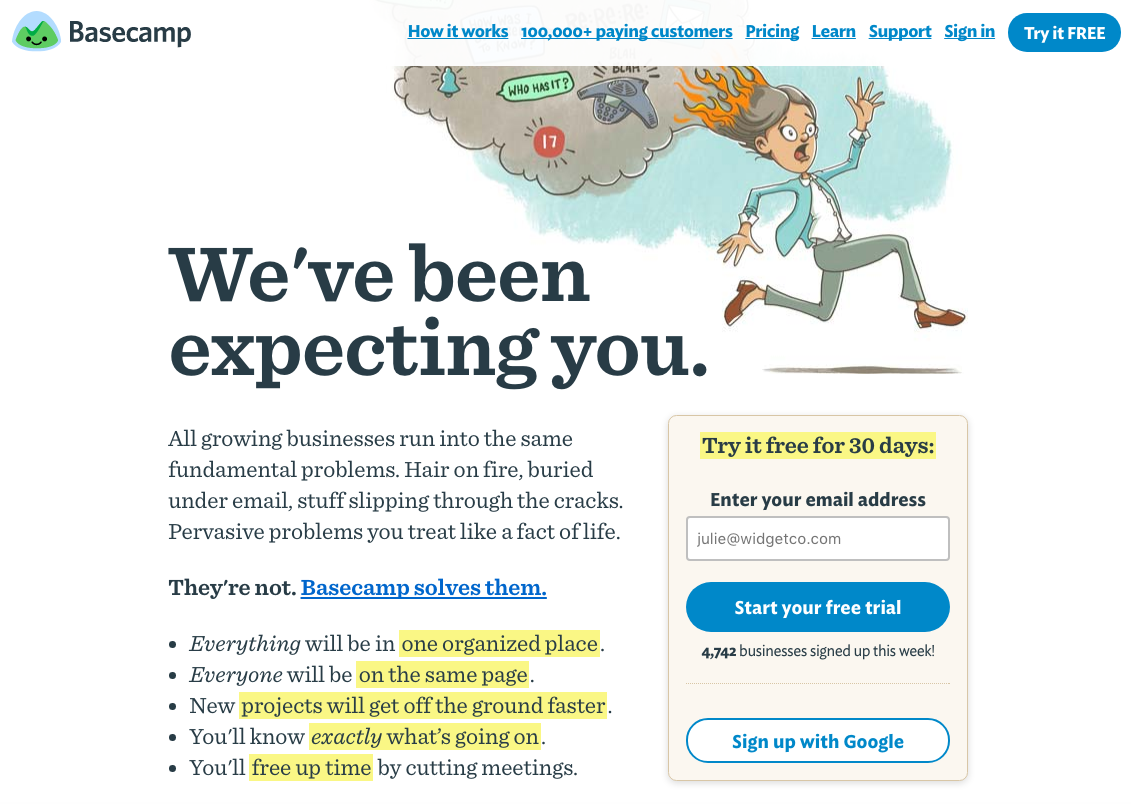
It draws you in with a big, bold headline. It highlights the key points in a list for easy skimming. It also features a noticeable sign up form.
But good landing pages don’t always need to be just one page. Check out this example from Bills.com:
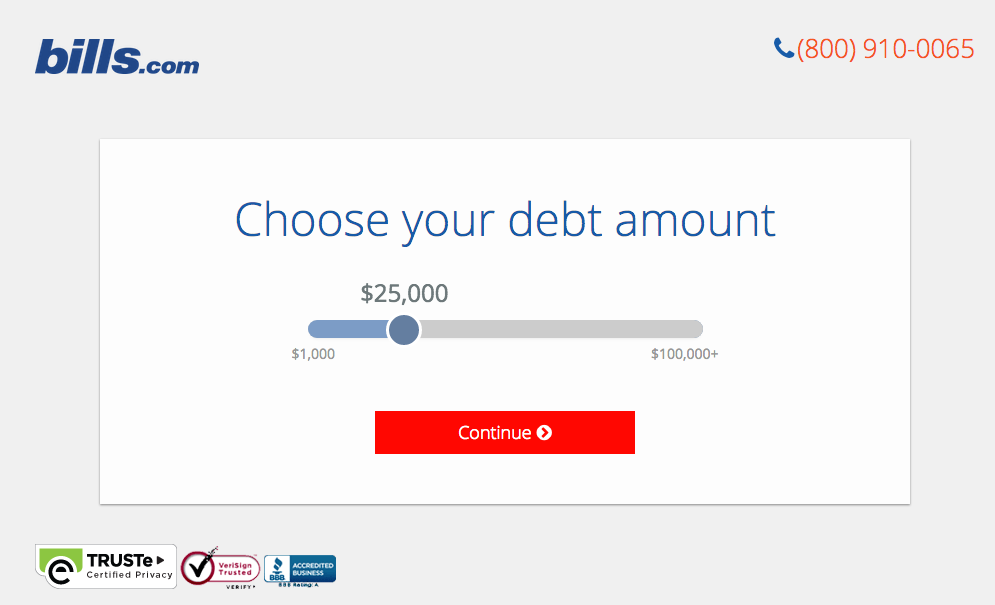
It features an interactive way to draw visitors in. First, you select how much debt you have.
I’m going to pick $50,000.
The landing page then asks me a series of questions, which are the company’s pre-qualifying questions for new leads.
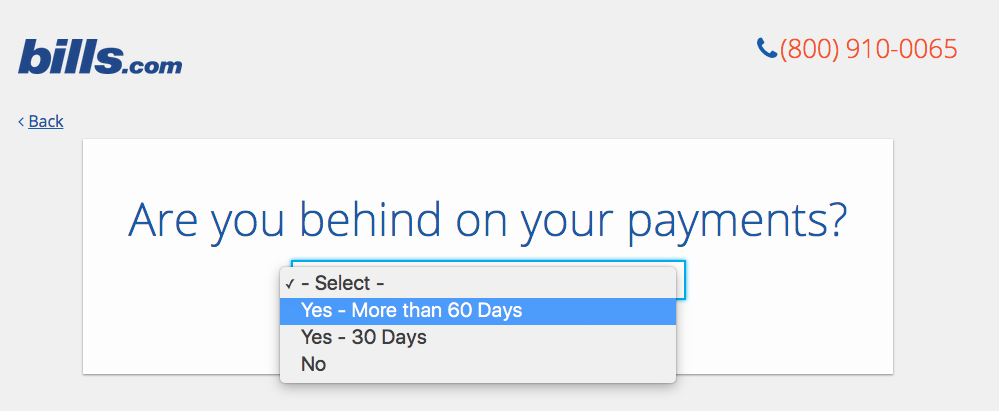
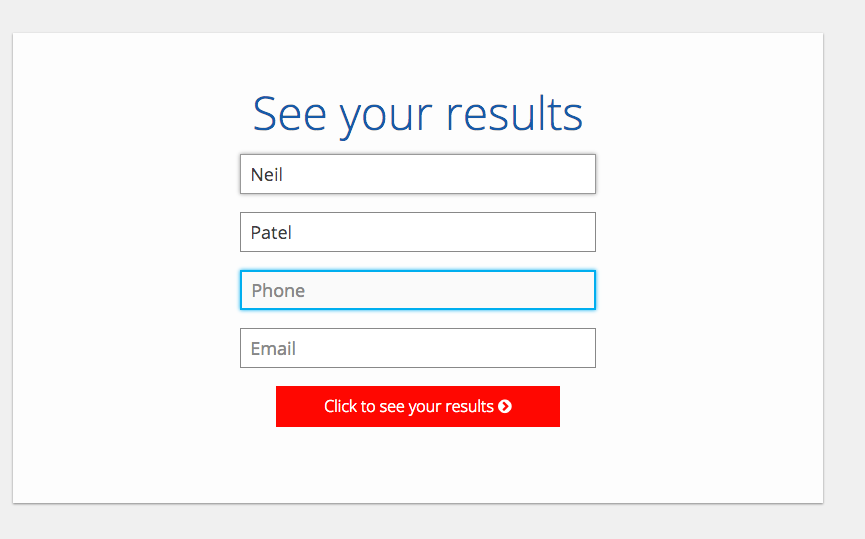
To see my results, I need to enter my contact information. Some visitors may not want to and abandon the landing page at this point, but those who really want to know if their debt relief program will help them will fill it out.
This is a very simple landing page that results in thousands of leads per month for Bills.com.
It’s a great example of how a simple design and interactive elements can easily come together to generate huge results.
Here’s how to make sure your landing page is SEO optimized.
Step 1: Use Long Tail Keywords
Find a long-tail keyword and use it throughout your landing page. For example, Copyblogger targets the keyword “SEO copywriting” on one of their landing pages.

If you use Optimizepress or another landing page creator for WordPress, make sure that you add title tags, a meta tag description, and keywords.
Use the keywords naturally throughout your content to avoid getting penalized for keyword stuffing. Include your long-tail keyword in the headline, at least one subheading on the page, and a few times in your body content.
Step 2: Use Compelling Copy to Share Useful Information
Your landing page content has to be useful.
Write to persuade people to take the next step. Every SEO expert will tell you that the #1 goal of all compelling copy is to get you to read the next sentence.
Remember that the anatomy of a successful landing page begins with the headline. Your body content is also important and should include a testimonial or review from a customer to add trust and credibility.
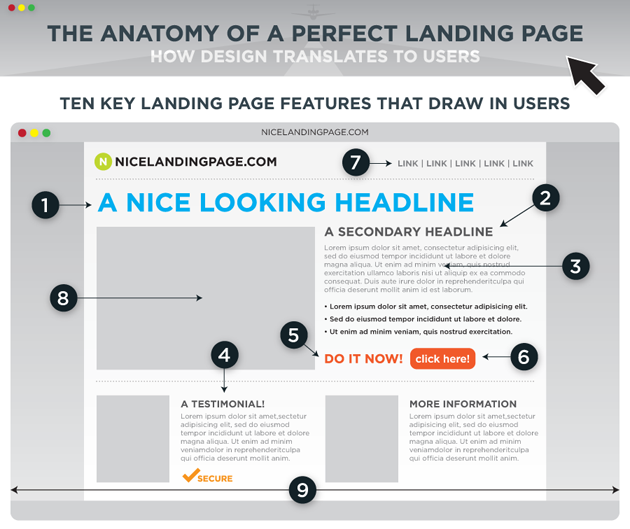
Step 3: Use a Professional Design
You also want to make sure your landing page looks modern with a professional design.
“Design is King,” says Derek Halpern. If your content is useful, but your design sucks, you’ll most likely fail.
Landing pages need strong copy, a persuasive video that’s emotionally appealing and testimonials from satisfied customers, which go a long way toward swaying new customers.
Step 4: Build Links
Finally, build links from your existing content to your new landing page.
There is no alternative to link building. Links are a huge ranking factor for Google and likely always will be.
Without quality links, your page will probably not rank very high in search, even if you have excellent copy or use every other SEO ranking factor out there. Since most users never look past the first page of search results, it’s important to rank as high as possible.
Advanced SEO Tip 4. Make Your Website is Mobile-Friendly
It’s more important than ever to make sure your website looks good and performs well on mobile devices. In fact, I’d say it needs to be more than mobile friendly — it needs to work really well on mobile.
Since Google went mobile first, they significantly boost organic search rankings for websites that work well on mobile devices.
Over 60% of daily searches are now performed on a mobile device.
When it comes to e-commerce, the numbers are even more surprising. Business Insider predicts that by 2020, 45% of all e-commerce (also called m-commerce) sales in the United States will be completed on a mobile device. That represents $284 billion in the US alone!

All these statistics are pointing to one thing: you simply cannot afford to not have a mobile-friendly website anymore.
Making your site look good on mobile is no longer a luxury, it’s a standard.
How can you tell if your website is mobile-friendly or not? Check out the example below from Google.

In the X example, the website looks just like it would on your desktop computer. The content doesn’t change size to fit a smaller screen better.
In the green checkmark example, see how the same content re-aligns itself to make better use of the small screen? It’s easier to read and scroll through. That’s what being mobile-friendly means.
If you use WordPress as a CMS for your website, you likely already have a mobile-friendly site. Pretty much all WordPress themes over the past few years are designed to be responsive, which is the design term for mobile-friendly.
According to Wikipedia, responsive design means:
Responsive web design (RWD) is an approach to web design aimed at allowing desktop webpages to be viewed in response to the size of the screen or web browser one is viewing with. In addition it’s important to understand that Responsive Web Design tasks include offering the same support to a variety of devices for a single website.
Still not sure if your website is mobile-friendly? Just check it out on your phone.
Here’s what my site looks like on desktop:
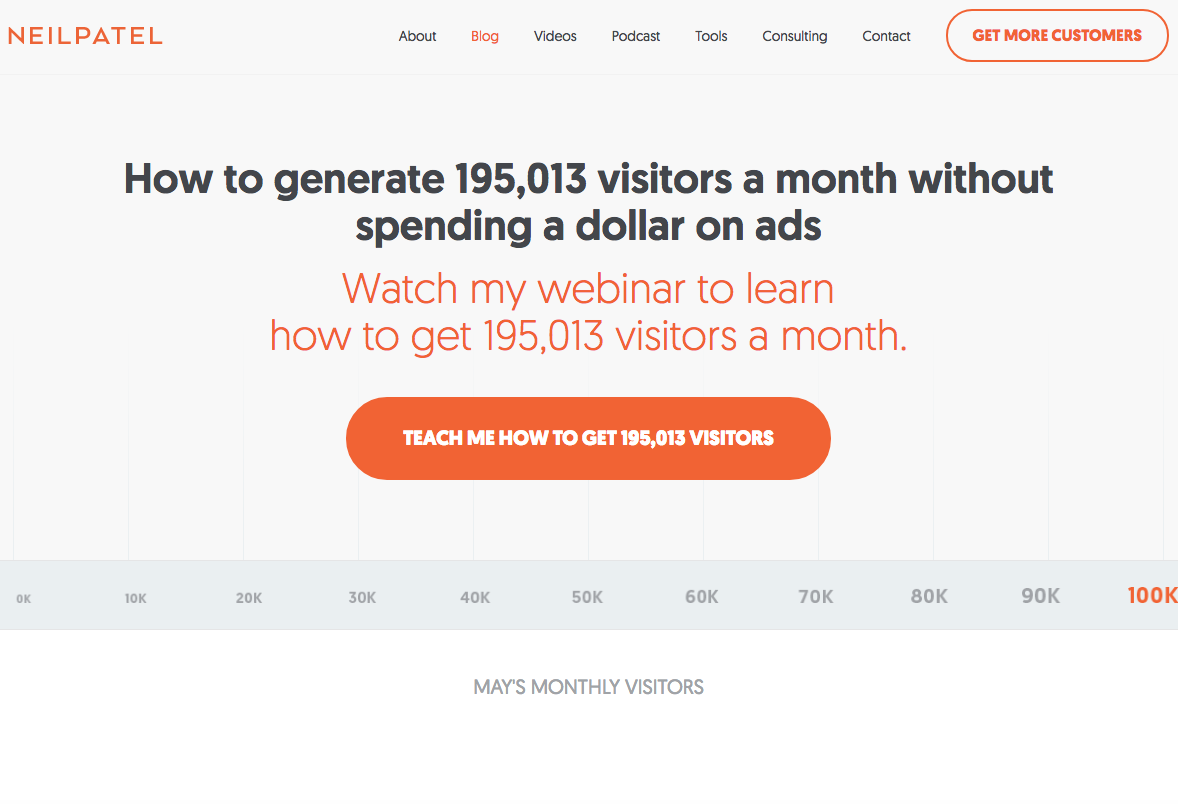
And what it looks like on mobile:
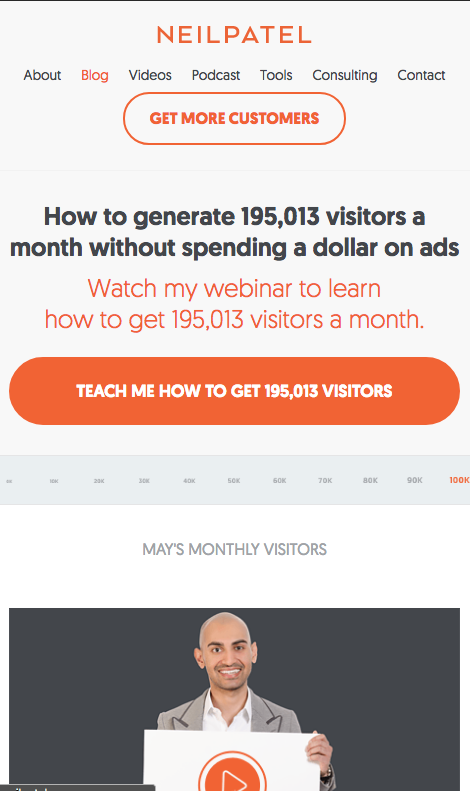
See the difference? The mobile site is optimized for my screen width and is easy to read.
If you want to be extra sure your website checks all the boxes for being mobile-friendly, use Google’s free Mobile Testing Tool.
Enter in your website URL and click Run Test.

You’ll get a results page that lets you know if your site is mobile-friendly or not.
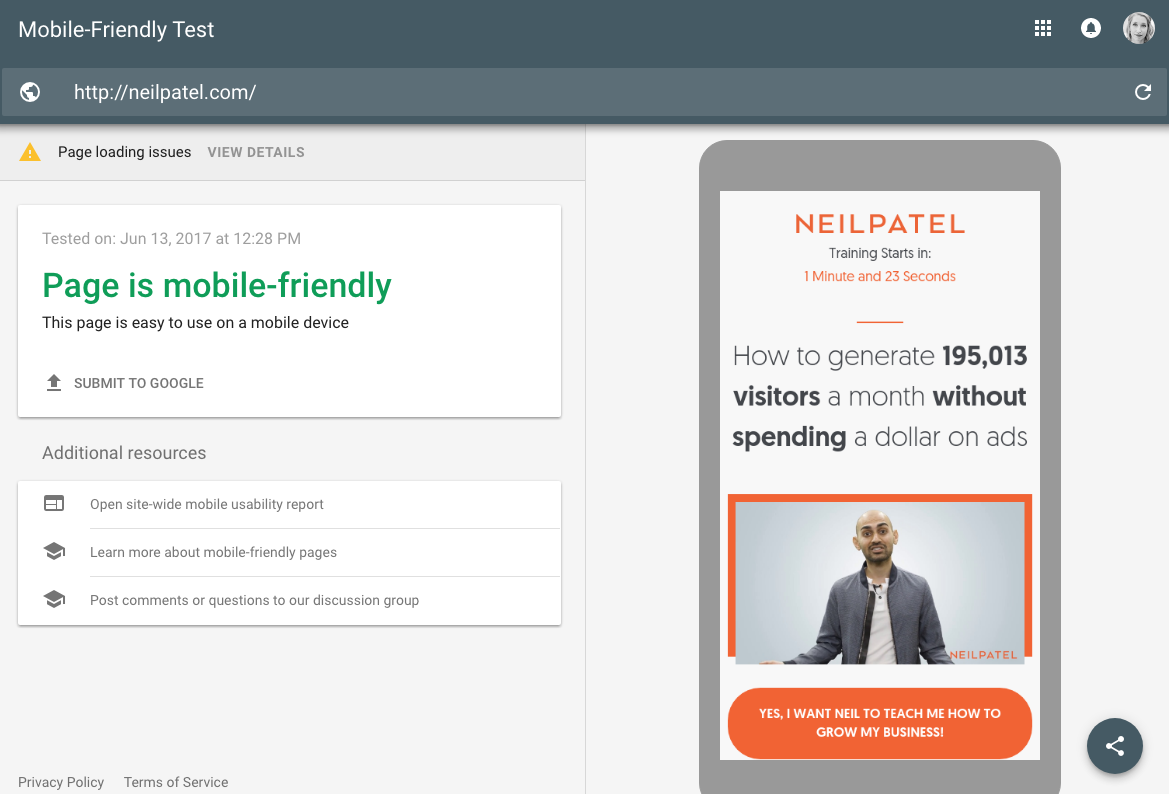
If your site comes back being not mobile-friendly, it’s time to redesign!
You can likely make a few tweaks to your existing website design to improve its usability on mobile. But it may be faster and cheaper in the long run to get a totally new website. Think of it as a good opportunity to freshen up your brand at the same time.
Advanced SEO Tip 5. Grow Your Traffic With Infographics
Infographics are popular because they allow you to display complex information in an easy to understand way. Since 65% of people are visual learners, a graphic goes a lot further than just a text article.
Here’s a good infographic on infographics from NeoMam Studios:

I’ve been creating infographics for quite some time now and the results are impressive. At KISSmetrics, we generated 2,512,596 visitors and 41,000 backlinks within 2 years, using infographics.
Quality infographics can increase your website traffic by 193%. I did that in just one year.
Unfortunately, most people don’t pay attention to the “info” part. Instead, they focus on the graphics. Good design is important, but you need to have quality facts to back it up.
Studies show an infographic is 30x more likely to be read than a regular text article. On average, websites who publish infographics grow traffic 12% faster than those who don’t.
Why do search users and consumers prefer infographics?
It’s because the human brain processes visual data 60,000 times faster than plain text. Also, 90% of information transmitted to the human brain is visual.

You could generate up to 60,000 search visitors to your website with infographics!
Here’s how:
Step #1: Get Your Stats
Find a trending topic or idea that people are searching for and put together some statistics on it.
For example, if you wanted to make an infographic about infographics, you could take the few stats we listed above:
- You could generate up to 60,000 visitors
- Your traffic could grow 12% faster
- An infographic is 30x more likely to be read
Step #2: Create the Infographic
There are plenty of free websites you can create infographics with, like visual.ly, Canva, and Venngage.
Don’t want to create it yourself? You can hire a professional infographic designer on Dribbble. Just search for infographics at the top.

From there, pick a designer and read their profile.
If you do want to create it yourself, here’s how to do that with Canva.
Login to Canva and click Create a Design then choose infographic.
Canva gives you some great layouts to start with. Pick one on the left-hand side. Click anywhere on the infographic to start editing it.
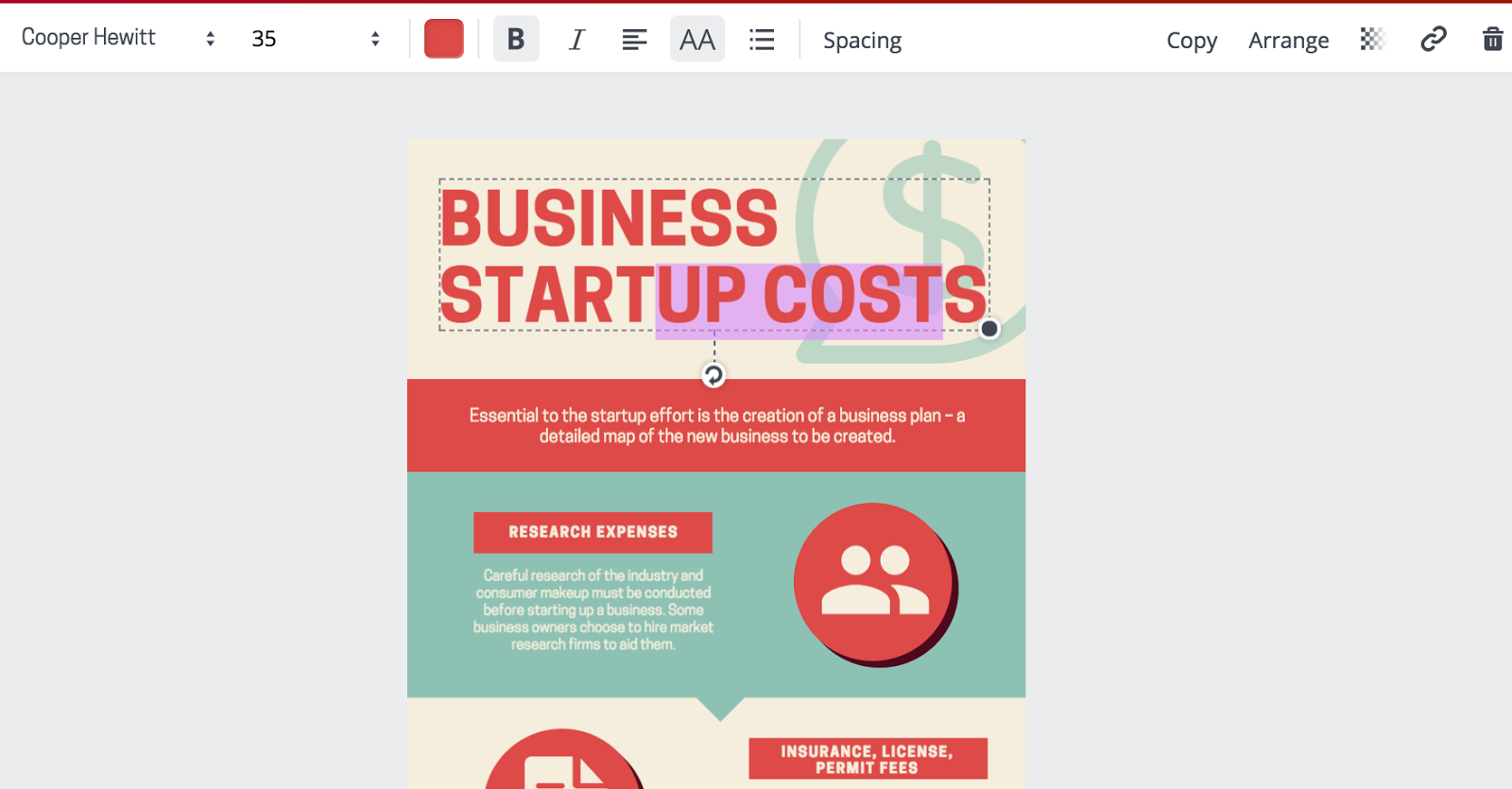
You can change the text and images until you’re happy with the result. Canva also has a library of free stock icons, photos, shapes, and charts you can find under the Elements tab.
Once your infographic is ready, click Download at the top and save it as a PNG file. This will automatically download it to your computer.

Step #3: Write a Blog Post Based on Your Infographic
Take the data from your infographic and turn it into an in-depth article to accompany the graphic.
People are more likely to share your infographic if it comes with a post that explains it.
For example, if your infographic is titled “10 ways to make your site load faster,” you can expand on each of the tips in your blog post.
If you can publish unique content of at least 2,000 words and couple it with your infographic, your search traffic will double over time.
Remember that Google doesn’t index the text on the infographic, that’s part of the image file. The only thing Google indexes is the image itself.
When you create a blog post to go with it, Google will index that content and make it more likely for your infographic to come up in image search results for that keyword.
Step #4: Submit Your Infographic to Directories
Once you have your infographic, submit it to these top 20 infographic directories.
If you don’t want to take the time to do it yourself, you could find someone on a site like Fiverr to do it for you. Just search for “submit infographics.”

Click on the submission services and study them carefully. You should ask providers to show you the sites they intend to submit to. If you’re not comfortable with the sites they name, let them know. You’re hiring them which means you’re in control!
Note: Focus on quality links over quantity when to avoid a Google penalty. That way you’ll improve your search traffic and sustain your rankings.
Advanced SEO Tip 6. Optimize Content for RankBrain
Search engines have evolved a lot since Google first launched in 1998.
If you want to keep thriving in search rankings, you need to be aware of all the latest Google algorithm updates and SEO best practices.
RankBrain is an artificial intelligence system that helps analyze search results. It learns what a page of content is about and how that relates to keywords people are searching for. Essentially, it helps connect a search with relevant results.
Let’s say you search for “remote work”.
That could mean a few different things:
- You’re searching for remote, or distance/telecommute, jobs
- Your remote control for the TV is broken and you want to make it work again
How does Google know which one you want?

RankBrain goes to work and determines that you want the first option based on thousands of other web searches performed by people looking for the same term.
A more popular example would be the difference between searching for apple and Apple:
- A fruit
- A large computer company founded by Steve Jobs
So, how do you tell Google the exact “apple” that you’re referring to? Is it the Apple Company or the apple fruit? Or, is it something different-but-related?

RankBrain tells Google’s spiders how to index your content based on your intent.
Since Google is a lot more sophisticated these days, we no longer need to stuff our content full of keywords to make it understand our intent.
Whatever you do, don’t stuff keywords into your content!
Keyword stuffing is when you overuse keywords and phrases that relate to the main keyword in attempts to rank higher in search. It’s a bad SEO practice that you should avoid it at all costs.
For example, consider these related keywords: iPhone reviews, best iPhone reviews, new iPhone reviews. When you use all of these keywords in your content, it’s likely that Google won’t rank that page well, especially if the content falls is only a few hundred words long.
Here’s an example of a keyword stuffed paragraph:
Do you want to learn java online? Most java tutorials are not created to help beginners learn java online, because the online java learning platforms are not user-friendly. But today, in the Los Angeles area, you can easily learn java online from the comfort of your home and become a java online expert.
Not great, right?
The main keyword “java online” was mentioned four times, which is too often for such a short paragraph.
There is a better way to change this paragraph and make it more user focused, without neglecting the main keyword – “java online.” All you have to do is find synonyms for the keyword. For example:
Are you ready to learn java online? It’s a good step towards upgrading your skills and giving you a better chance of getting that job. There are several places to learn java on the web, and within 2 – 3 months, you’ll be programming in java. Most people don’t like the idea of taking online java courses, but I believe it’s one of the most flexible ways to get access to a wealth of knowledge and become skilled in your life’s pursuit.
The difference is clear, right?
The second paragraph sounds better to users and still uses your keyword without overdoing it.
That’s the power behind RankBrain.
A few guidelines for finding synonyms for your main keyword:
- Find keywords with the same meaning as the principle keyword, but with different spelling and structure. Example: image, picture, photo.
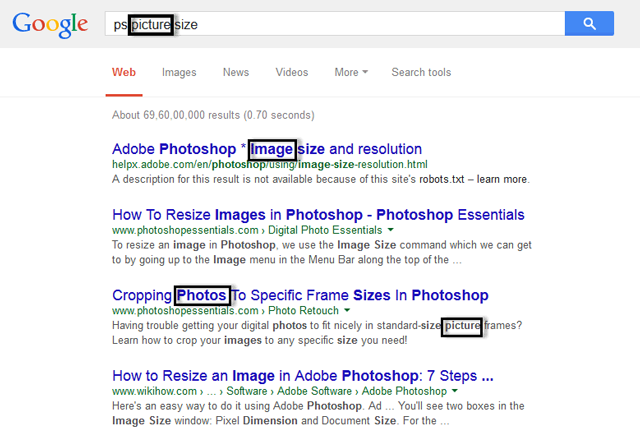
- Don’t over-optimize for other keywords or you could get penalized. Only use them when necessary and make sure your copy flows naturally when a human reads it!
- Write in a natural tone. Make sure that the new keywords don’t override the main keyword that you want to rank for. The new key phrases are only there to give additional meaning to your content and to help Google understand the context of what you’re talking about.
A good example of these practices is Marketing Land.
Marketing Land optimizes content for a main keyword and several synonyms. They know that once YouTube is mentioned, terms like videos, channels, and video source need to be mentioned, too.
Where Facebook is mentioned sharing, liking, and commenting are also included as they’re all common activities that take place on the platform.
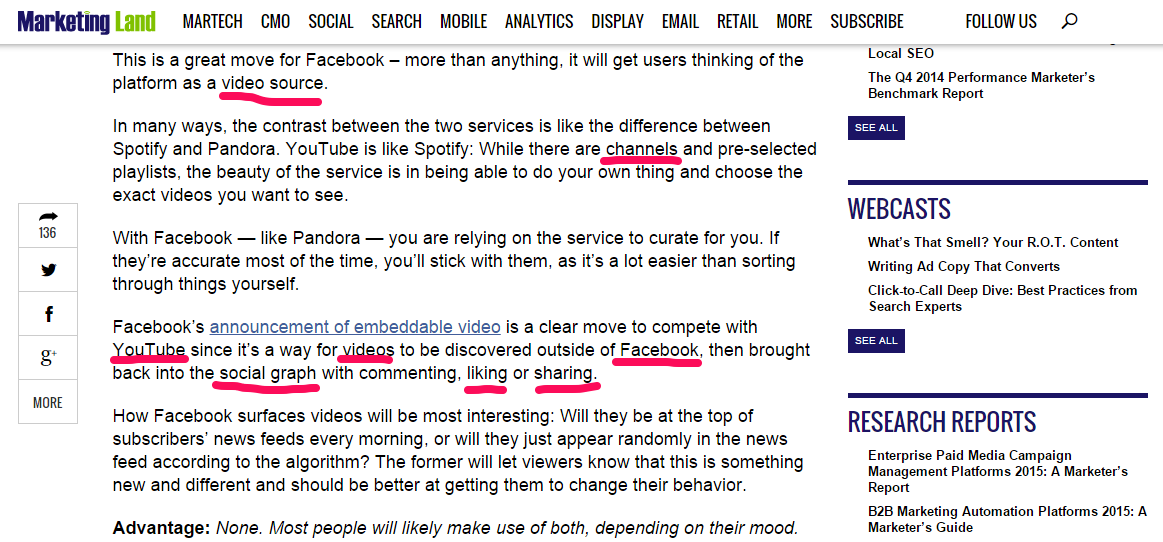
Google looks out for these key terms in your content. As long as you’re including them in a natural-sounding way, your search rankings will continue to improve.
Advanced SEO Tip 7. Write at Least 1,447 Words
Backlinko analyzed 11.8 million searches and found the mean first-page search result had 1,447 words.
There have been numerous studies and experiments on the correlation between content length and search engine ranking.
This graph from Backlinko pages with a higher word count tend to help you crack the first page of Google. It won’t necessarily help you hit number one, but it can help you get close.
I did an experiment for QuickSprout. The results showed that my posts over 1,500 words received almost double the amount of social shares than the ones under 1,500 words.
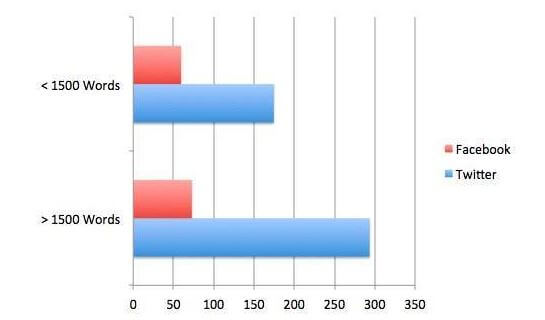
Content length isn’t everything. A shorter blog post that’s higher quality will still outperform a longer, low-quality post.
The trick is to cover one topic in so much detail that every part of the post is valuable to the reader. Making it more valuable to humans makes it more valuable to Google as a page to display in search results.
A key benefit of longer content is that it will naturally contain more relevant keywords and rank for them.
Consistently publishing informative content over 1,447 words will yield big returns in organic search traffic.
Advanced SEO Tip 8. Write a Roundup Post
A roundup post is when you interview a few people about the same topic or make a list of the “best” of something.
Not only is it a great way to get different viewpoints and learn new things, it also helps grow your SEO rankings and traffic.
Here’s an example: 53 Best SEO Experts of 2020: A More Diverse Roundup
The author of this post collected the names and profiles of experts in their field, including where they work, what type of information they share, and where to follow them.
It seems simple because it is, and it works!
The key benefit of these posts is that it allows you to get your website in front of lots of new audiences, thanks to the experts you’re interviewing.
If you were featured in a roundup, you’d share that with your audience, right?
Deirdre Breakenridge is one of the experts featured in the post above about PR. She has over 30,000 Twitter followers.

If she tweeted out your roundup post even once, there’s a good chance some of her audience would click to read it.
Those are people you wouldn’t have been able to reach otherwise.
Creating a roundup post that grows your traffic is easy:
Step #1: Pick a Topic and a Good Question
For example, if I wanted to write a post about tips to grow your traffic, I could ask, “What one strategy has grown your website traffic the most?”
Step #2: Make a List of Experts and Reach Out
Make a list of as many experts in the topic you want to write about as you can. If you want to feature 10 expert opinions, make a list of 20 experts at least.
It may not be easy to find their email addresses, so write down their social media profiles instead.
Then, reach out with a nice email/social media message and ask them for their opinion!
Remember to include that you’ll be linking back to their website as a thank you for contributing.
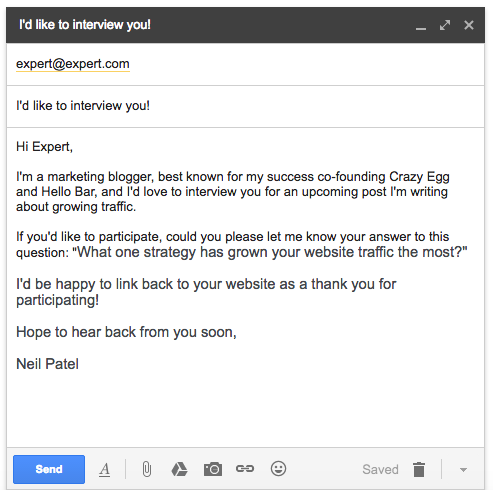
Step #3: Write and Publish the Post
Collect all the answers, then write and intro and conclusion. Make sure to link back to everyone featured.
After you’ve published it, be sure to send a follow up email, or social media message, to let them know the post went live.
Ask them to share it with their audience.
Even if only half of your 10 experts share it, that’s still five more audiences than you would have reached by yourself. And depending on the size of your expert’s audience, that could be thousands or tens of thousands of new people visiting your website.
Brian Liang wrote a roundup post about how to promote your blog.
He got over 40 experts to contribute to it, resulting in a comprehensive and informative piece that got over 5,000 shares on social media. It was also Buzzsumo’s most shared post of that week for the term “blog promotion.”
The biggest wow factor? His blog wasn’t even well-known at the time!
What would 5,000 shares do for your brand?
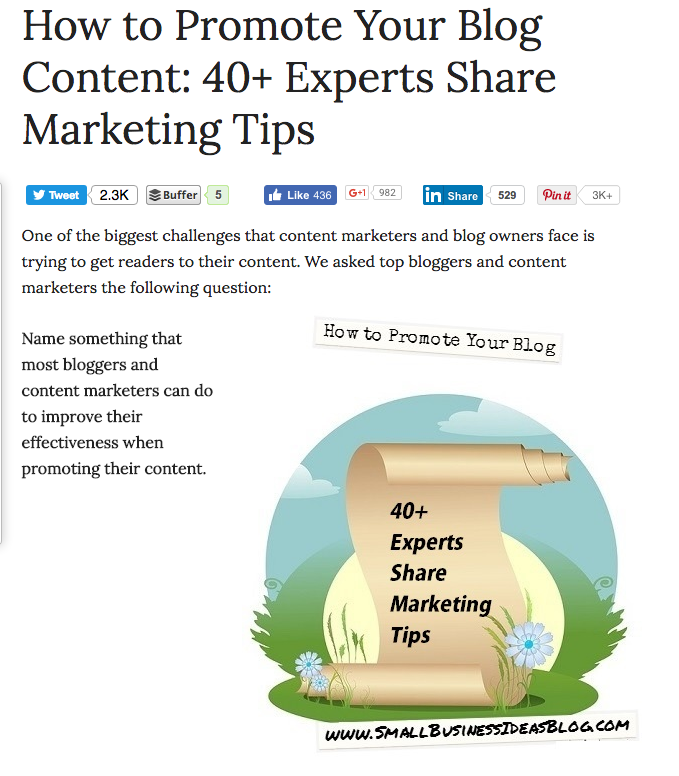
Advanced SEO Tip 9. Post Valuable Content on Social
If your blog is new, it can be difficult to rank well in Google search results for high volume keywords because your Domain Authority and Page Authority are still very low.
However, you can use social media platforms to gain credibility and traffic.
In the screenshot below, you can see the Page Authority (PA) and Domain Authority (DA) for each search result. I’m using the free MozBar to see this information.
Page Authority was developed by Moz, and it means the likelihood that your page will rank highly in search. A higher number means it’s more likely to rank well.
This is based on several factors: content length, links, keywords, readability and more.
Domain Authority is the overall likelihood that your whole website, or domain, will rank highly in search.
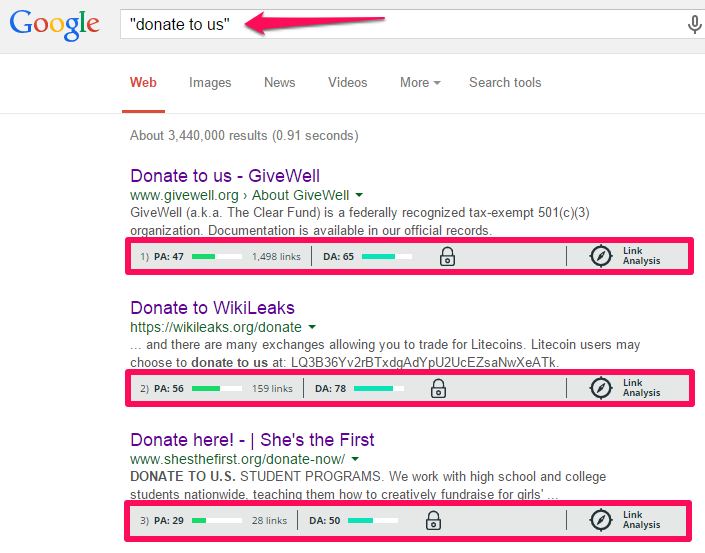
But not all social media platforms are created equal when it comes to building authority and traffic.
I’m not talking about Facebook, Twitter, or Pinterest where anyone can post whatever they want. I’m talking about authoritative platforms where quality content is expected.
A few examples are Slideshare, Blogger, and Quora. These sites give you the opportunity to improve your search rankings, as well as build a following, within a short period of time.

Does leveraging authority social platforms increase your search traffic and rankings?
Yes!
For example, Ana Hoffman got 243,000 views in 30 days, in addition to other benefits, using Slideshare content. Her presentations were among the top most-viewed slide decks.

If you’d like to leverage Slideshare as a search traffic booster, here are the basic steps that you should take:
Step #1: Find a Trending Topic
In my experience, simply selecting a keyword and creating a top-notch slideshow presentation doesn’t always generate buzz on social media.
Instead, look for topics that are already trending on blogs. Just as you do when looking for blog post ideas, you should identify what people are talking about right now.
Another great place is GrowthHackers, an online community of marketers. You’ll find lots of trending topics. Pick one that interests you and is related to your business or industry.
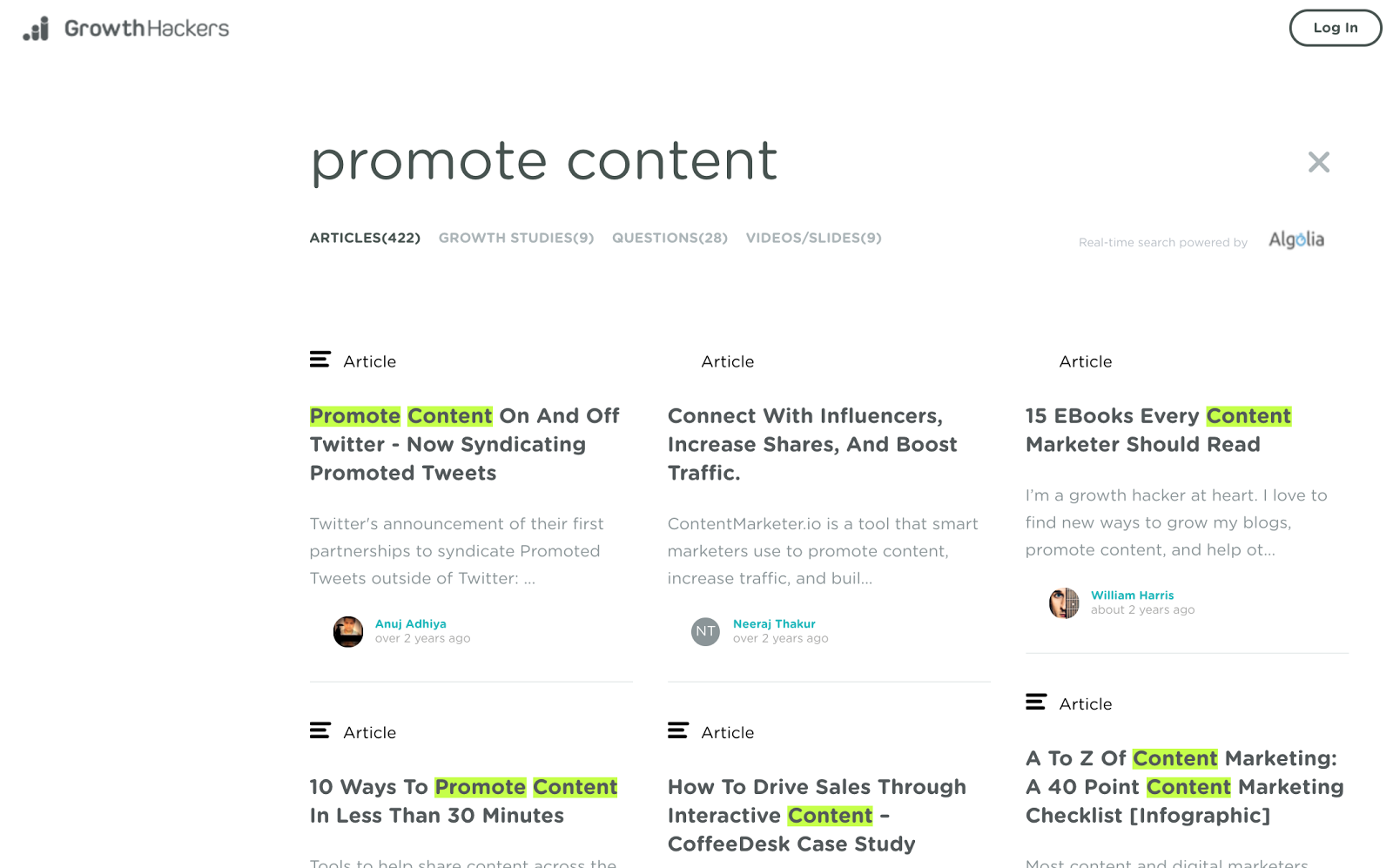
The article titled “10 Ways to Promote Content in Less Than 30 Minutes” would make a good Slideshare presentation.
Don’t feel pressured to crank out 50 or 100 slides.
Aim for about 35 slides. This gives a user a good amount of information without being too long to keep their attention.
Step #2: Make an Outline
Read the article you selected in step 1, pick out key points, and create an outline for your presentation. This will make it easier to put together the full presentation.
Your Slideshare presentation outline could be something as simple as:
- Join HARO
- Publish a press release
- Update your email signature
- Comment on other influential blogs
- Mention your sources on Twitter
- Scoop.it
- Use BuzzBundle
- Post in LinkedIn Groups
- Post to StumbleUpon
Each item in your outline represents a single slide.
If you want to make a presentation based solely on someone else’s post or article, make sure you get their consent first to avoid plagiarism. Do that before moving on to the next step and don’t forget to credit the author of the post that inspired you in your presentation.
Step #3: Find Supporting Images
Slideshare presentations are all about using images to captivate and hold the viewer’s attention. You can find free stock photos by searching Google for “free stock photos.”

Gratisography is another place where you can download free stock photos without copyright restrictions.

A few advanced SEO tips for images:
- Pick photos that are relevant to your topic or point
- Use high-resolution images/photos
- Use free stock photos, with no copyright restrictions
- Use images as accents — don’t let them overpower your text
You can also create your own images, rather than using stock photos.
Step #4: Study Successful Slideshare Presentations
Learning from experts is the best way to grow your own traffic and search rankings.
Popular presentations are featured on the Slideshare homepage. Study them carefully. Consider how you could improve them.
Could you design it better? Could you find more facts and data to back up the points made? If the answer is yes, make your own presentation.
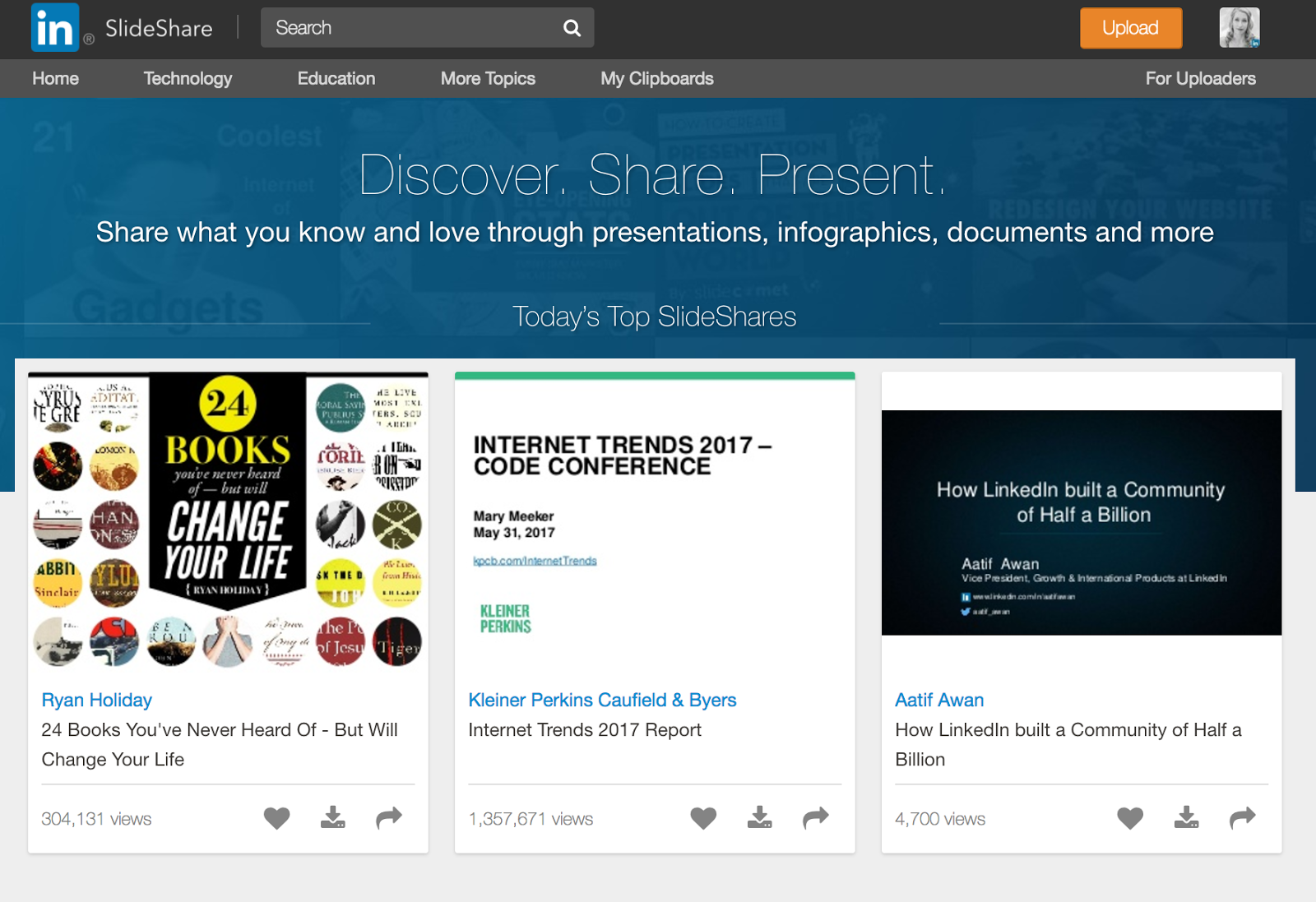
Step #5: Create Your SlideShare Presentation
With all of the information you’ve gathered, create your presentation! Try to make it really stand out from the other ones you studied.
You can use any software you like to create the presentation: PowerPoint, Keynote, Photoshop and save as a PDF, whatever you’re comfortable with.
You can even use Canva to create a SlideShare presentation.
Don’t forget to include a link to your chosen landing page for the topic. The link that comes from SlideShare is dofollow, so you’ll get link juice to boost your search rankings.

This presentation is directing people to their lead magnet for doubling leads and sales, which takes you to this landing page:
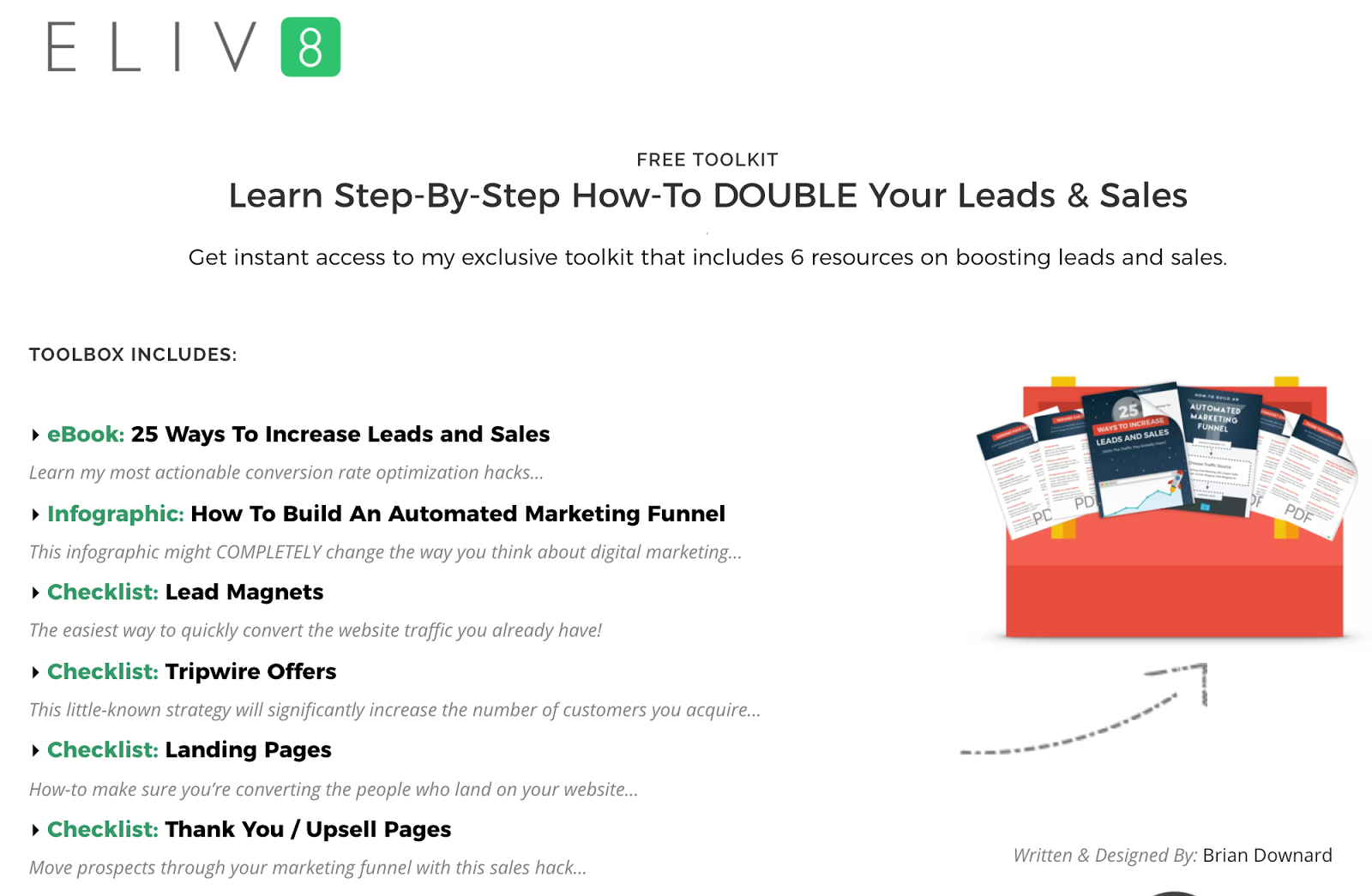
This is a great way of getting leads and subscribers for your email list.
Advanced SEO Tip 10. Use Advanced SEO Internal Deep Linking
Deep linking is the practice of using anchor text to link to other pages inside your blog. This shows Google the depth of your site’s pages and encourages it to index more of them.
Most people focus on getting search visitors to their homepage, but struggle to rank their internal pages.

Your older blog posts and landing pages that provide immense value on relevant topics can pull in a lot of new traffic. You should link to them often to help build the structure of your website.
Without establishing internal links, a Google spider may see your website this way:

Pages C and D could be very important, but the spider can’t easily see them.
When your content is properly linked to each other, it helps the Google see all your content in an organized way, like this:

When you start interlinking pages other than your homepage, you’ll improve the SEO value for those internal pages and improve their ranking — even for tough keywords.
Before you start link building to your inner pages, you should first check to see how many inbound links go to your homepage, as compared to your other pages.
Step #1: See How Many Inbound Links You Have
Go to Moz’s Link Explorer. Enter your URL into the search box and click “Get free link data”.

Step #2: View Top Pages
Sign up for access, then login. Click on “Top Pages,” in the left-hand menu under overview.
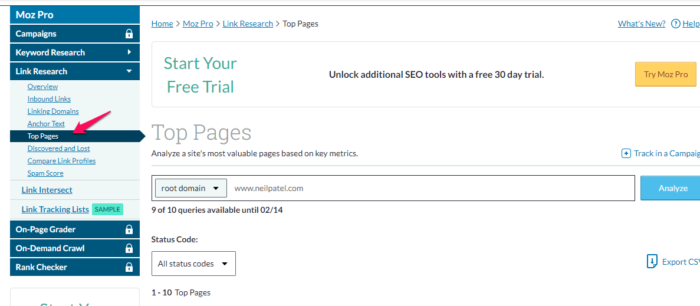
Step #3: Look at the Inbound Links for Your Homepage
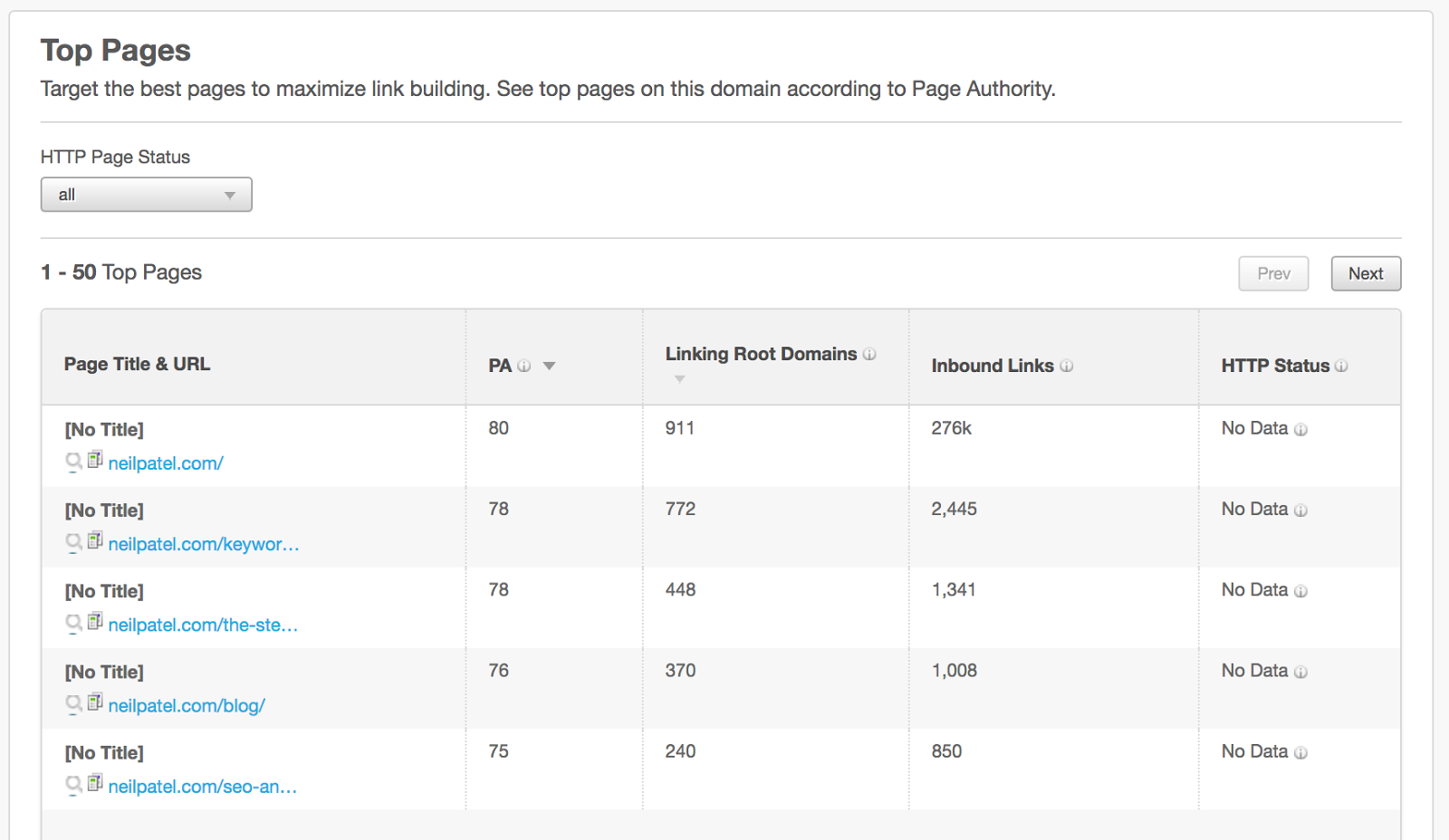
Looking at the above screenshot, you can see that my homepage has 276,000 inbound links, but the next highest number of links for an internal page is only 2,445.
That’s still a good number of links to have, but much lower than 276,000!
A high bounce rate often happens to websites who receive a significantly higher level of links to their homepage than they do for internal pages.
One of the strategies that worked best for me to lower my bounce rate is deep linking. Using this tactic, I was able to drop my average bounce rate from 45.34% to 24.45%.
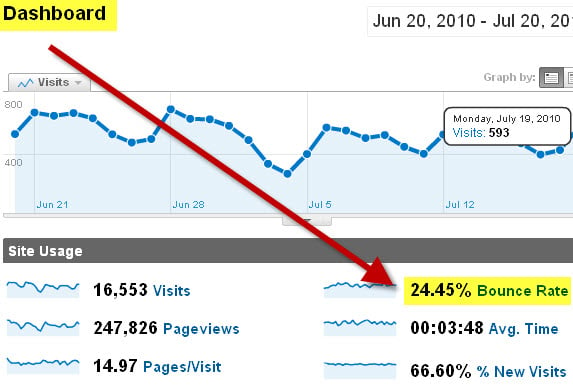
Here are a few other ways deep linking to internal content helps your rankings:
Improves Page Authority: Google likes fresh content, because recent information is more likely to be relevant and useful to users.
Adding fresh content regularly is not the only way to raise your Page Authority. Linking to your older content gives those pages more power and tells Google they’re still relevant.
Your homepage naturally may have a higher PA but you need to work towards improving the authority of internal pages.
Cyrus Shepard explained, in a Moz post, that Google gives fresh content a score based on the date that it was published.
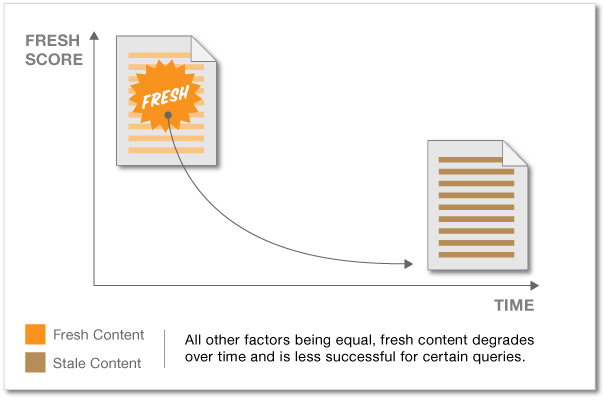
This freshness score can decay over time and it’s also responsible for increasing or decreasing the search ranking of that page. While freshness isn’t important for every page, it still matters!
Makes your internal pages indexable. Consistently linking to internal pages makes it easier for search engine spiders to quickly find and index them.
When linking to your internal pages from other blogs, avoid over-optimization of your anchor text.
Your anchor text is the actual part of your sentence that has the link in it, like this. Use something simple for your anchor text, like your website name (“Neil Patel”), or add a keyword (“Neil Patel’s content marketing”).
An easy way to link to internal pages is in your latest blog post, like I’m doing right now when I say things like you could double your traffic.
The words “double your traffic” are a good example of anchor text, and I linked over to an older post with more tips on growing your blog which is relevant to my current topic.
Advanced SEO Tip 11. Send Link Juice to Lower-Ranked Pages
If you have a page that’s currently on page two or three of Google search results, you can help move it up to page one by passing on quality link juice to those lower ranked pages.
Link juice (aka link equity) refers to outbound links from high authority sources to your content. Since those links are from high authority websites, that reputation rubs off on your site. Essentially, this gives Google an indication that your content is high quality, too.
Let’s look at it this way: you have two websites that are 100% identical – same design, same content. If every other factor were the same, the site with the most links would rank the highest in search results.
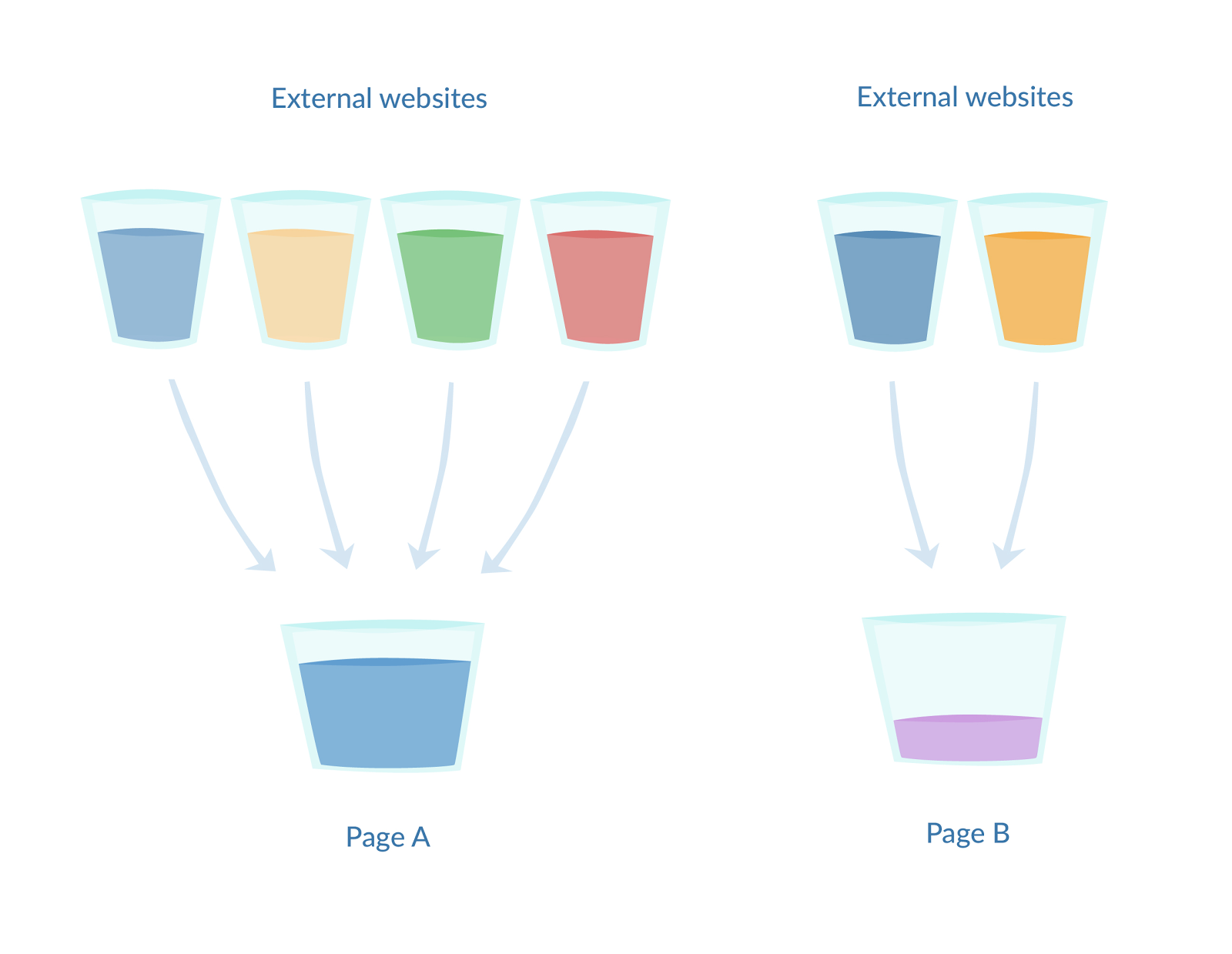
This article about indexing used to be on page two of Google’s results for the search term “index your site”.
Now, it’s the third organic search result on page 1!
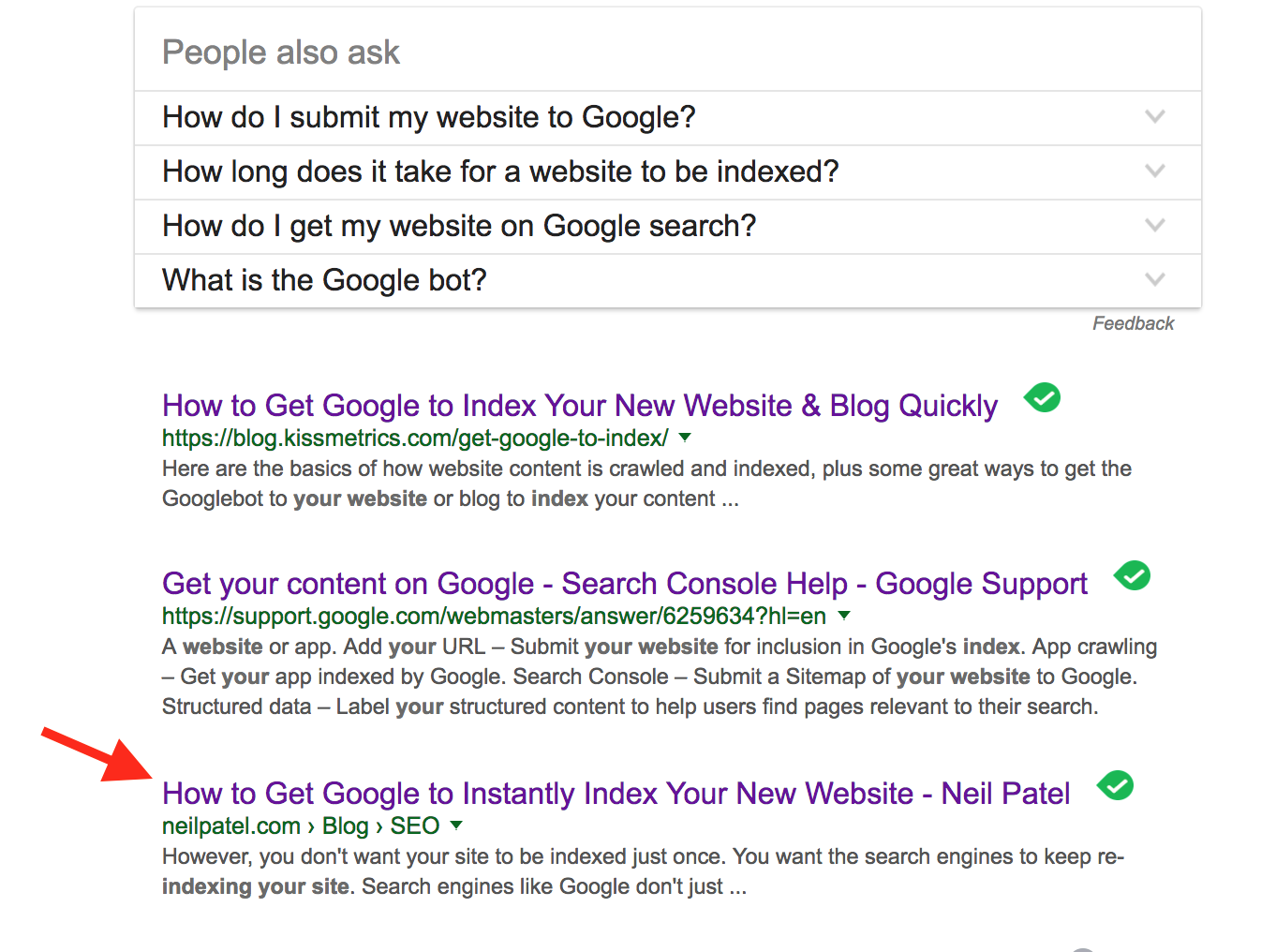
Here’s how I did it.
Step #1: Updated the Post
I added new links, content and recent data to bring the post up to date.
I cover how to update your older content in detail in Section 18!
Step #2: Shared It Across Social Media Again
Since I updated the post, I shared it on all my social networks again. This brought in a lot of new traffic.
Step #3: Linked to It From Newer Posts
Every time it was relevant to a new post I was writing, I included a link to this post. This directed traffic to the older post and resulted in people sharing it and linking to it themselves.
It doesn’t happen overnight, but over the span of a few months, I went from page two to almost the top of page one.
Advanced SEO Tip 12. Link to External Sites with High Domain Authority
It helps pass link juice to your content when you get links from high authority domains. Likewise, it also helps your overall trustworthiness in Google’s eyes when you link to high authority sites.
A good place to look for sites to link to is Alltop.
You’ll see some featured sites on the homepage and recent content published by them.

All six of these options would be good to link to, and get links from.
To find something for your topic, just search for your keyword at the top of the page.

You’ll see related categories to what you typed in. I chose SEO here.
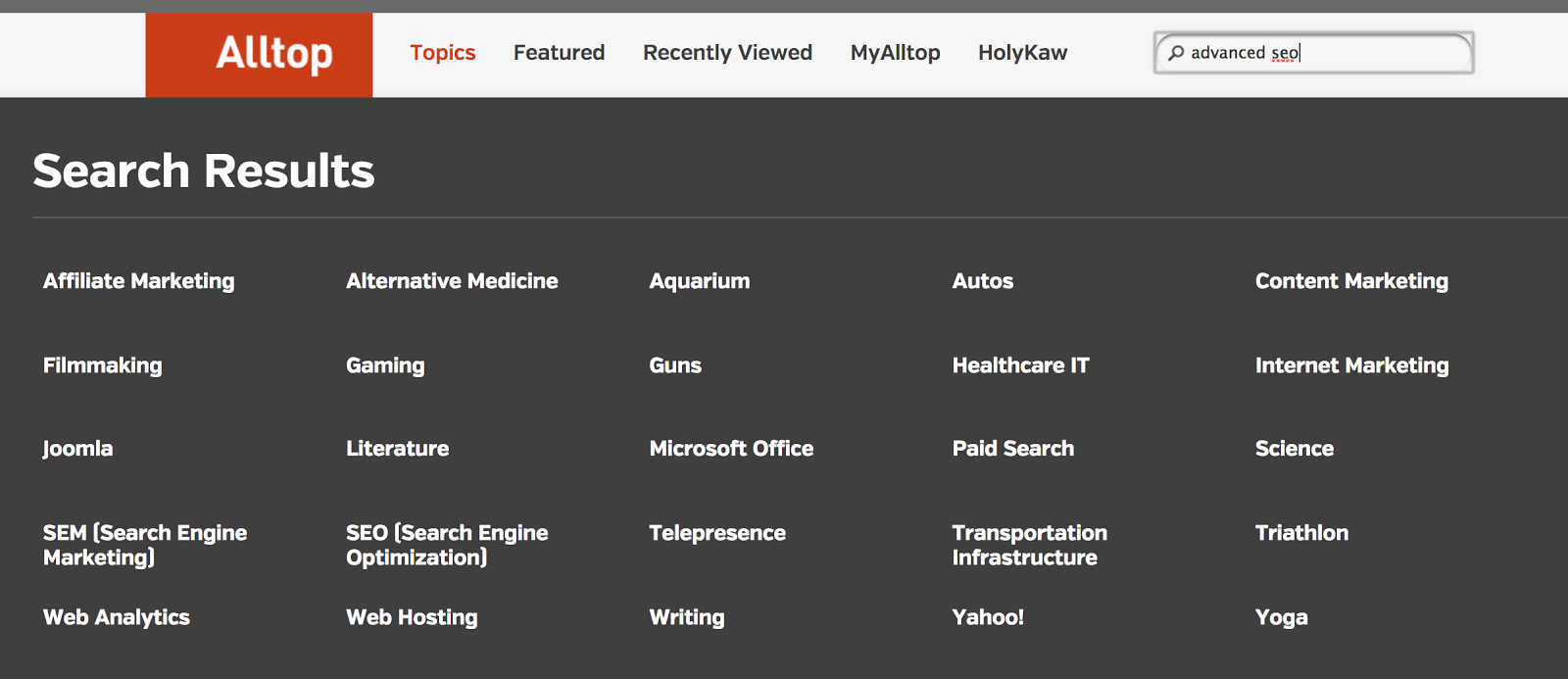
Alltop then shows me the top SEO related content from the following high authority websites:

I could link over to one of them as a data source in my content.
Like if I said that user experience was just as important as on-page SEO for ranking high in search.
Better yet, I could approach these websites and ask them to link back to my content.
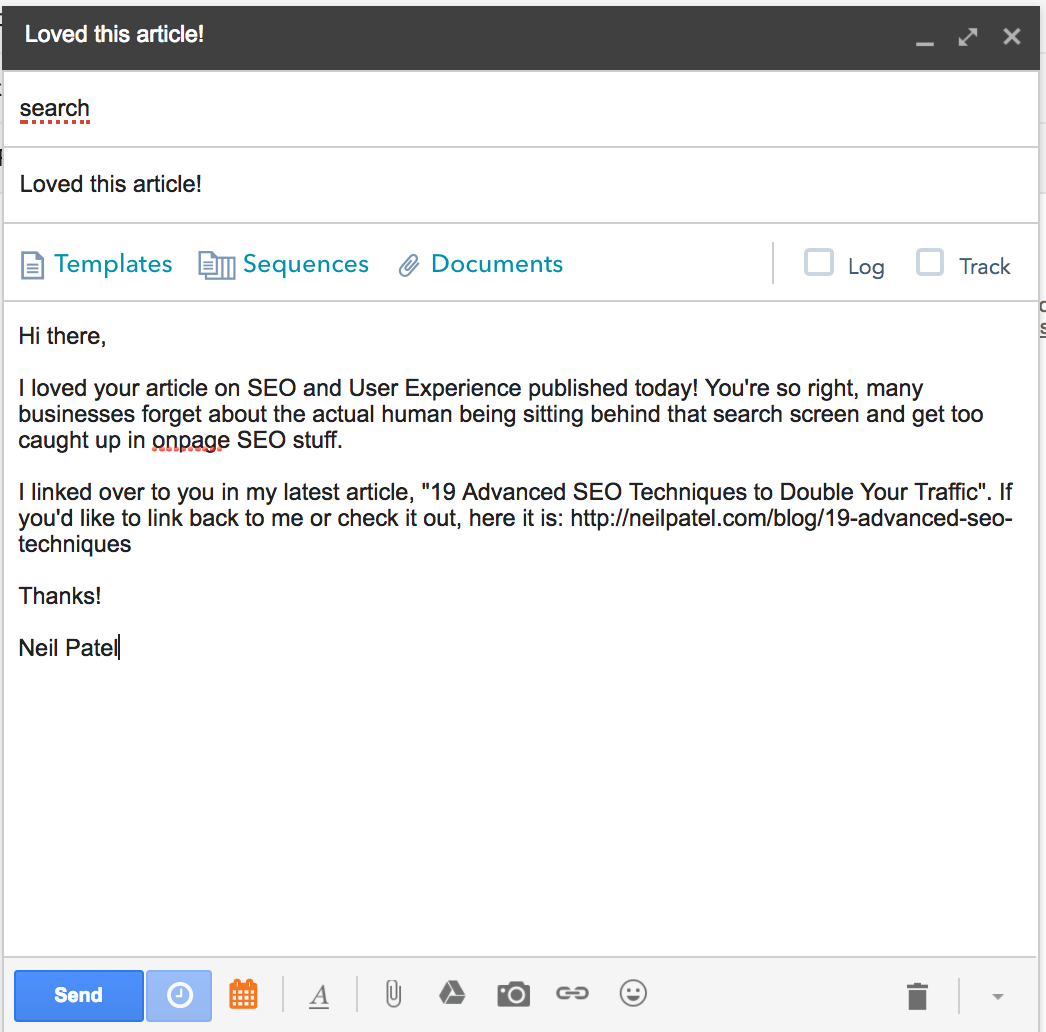
They may not link back to you, but a simple email only takes a minute to write. That minute could result in huge traffic gains later on, so it’s worth the time.
Advanced SEO Tip 13. Snag Broken Link Opportunities on Wikipedia to Build Links
This is something a lot of marketers overlook, but it’s very powerful for generating high authority backlinks to your content.
Scan Wikipedia for dead links and claim them as your own!
Didn’t think of that, did you?
There are two types of links you can get from Wikipedia:
- Citation needed: This means someone editing a Wikipedia article mentioned a statistic or fact without linking to a source.
- Dead link: This is a source that was previously linked to but for whatever reason, the website or page does not exist anymore.
If you can write a post about the topic, and be a credible source of information, you can get these valuable links from Wikipedia.
I like to use a tool called WikiGrabber to find these link opportunities. Enter your keyword and click Search.
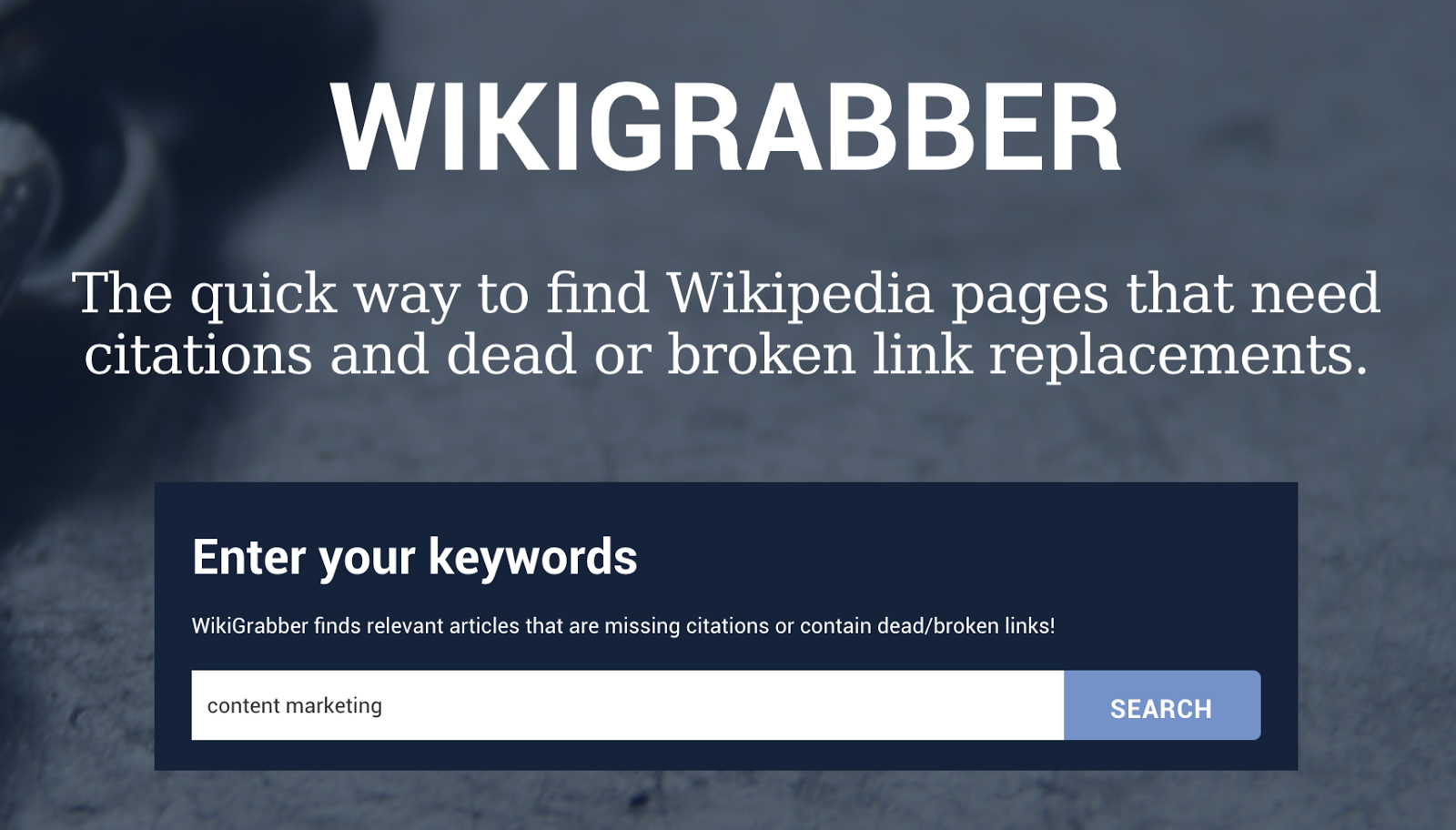
WikiGrabber then shows me this list of Wikipedia articles that need citations or that have dead links.
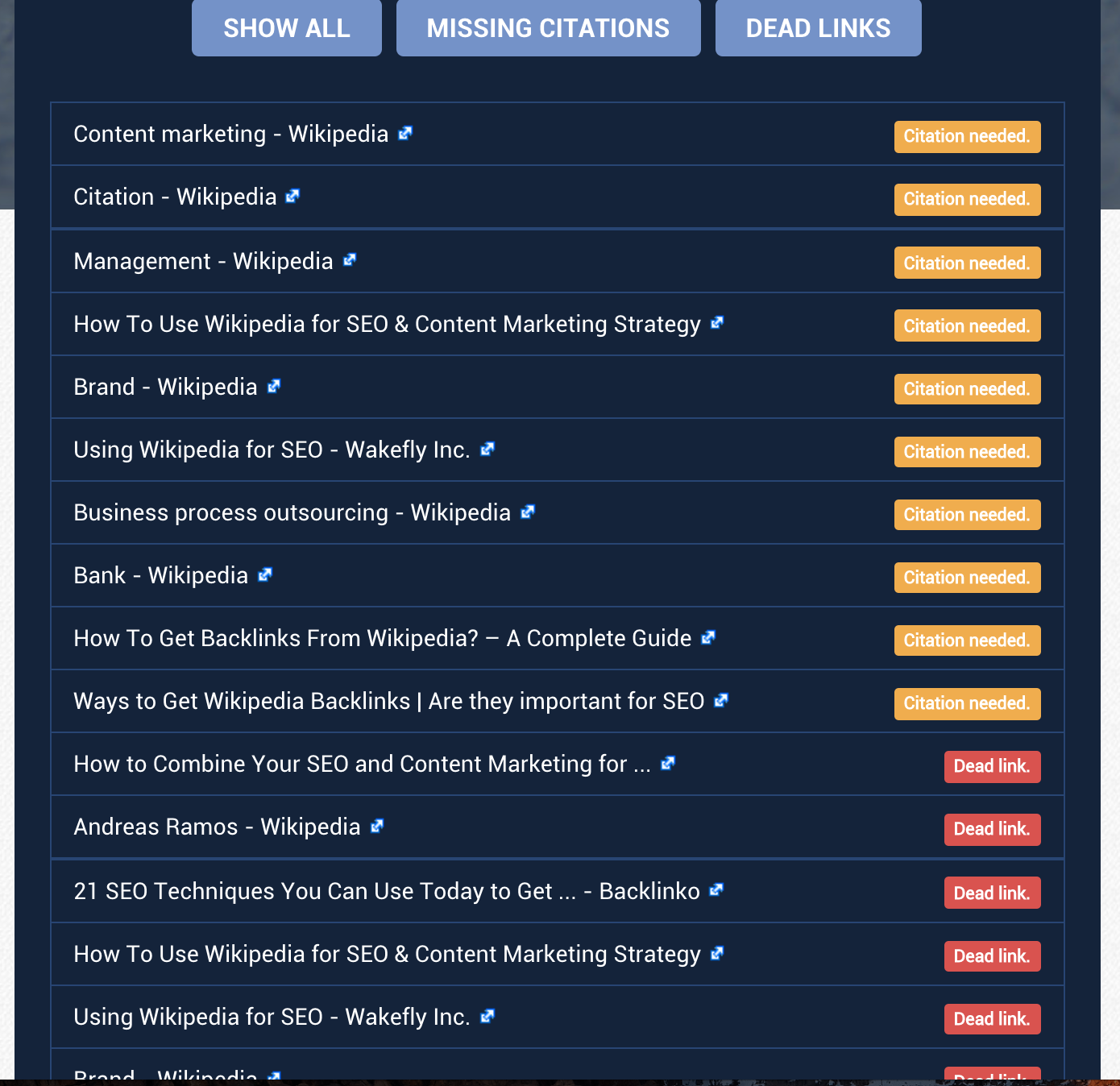
You can also use Google to find dead links on Wikipedia. Use the following search term:
site:wikipedia.org “Keyword phrase” “dead link”
For “content marketing”, you get the following results:
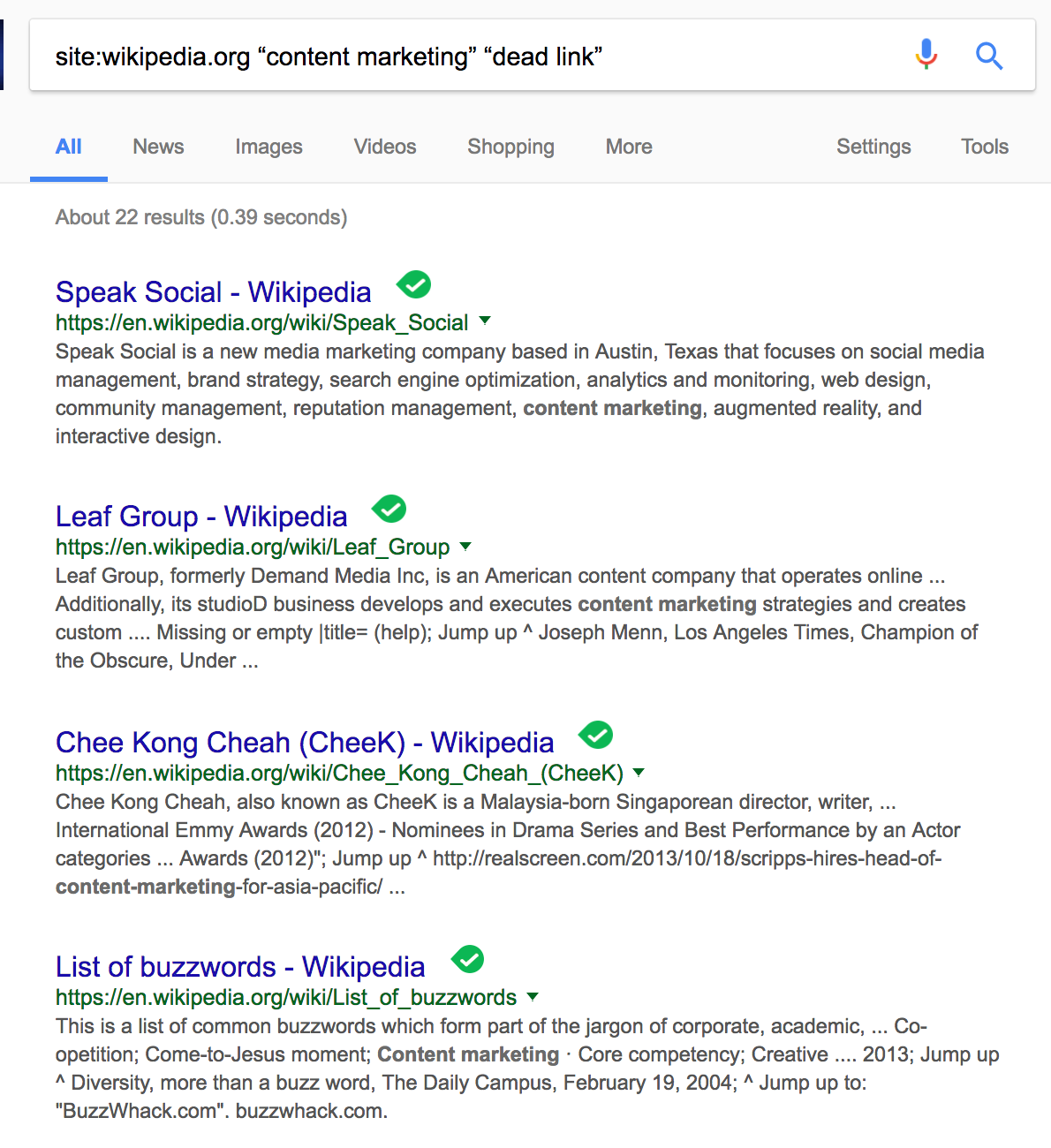
Let’s check out this article on Content Marketing.
Scroll through the article until you see the text [citation needed].

Read over the item that needs a source. If you have content that already backs up this statement, you can move ahead to submitting your link. If not, you will need to write a new post that thoroughly covers the topic and provides verifiable data.
To submit your link, click on the [edit] text beside Digital content marketing.
You’ll get the Wikipedia editor screen. Find the sentence that needed a citation, click at the end of it and click on Cite on the top menu.
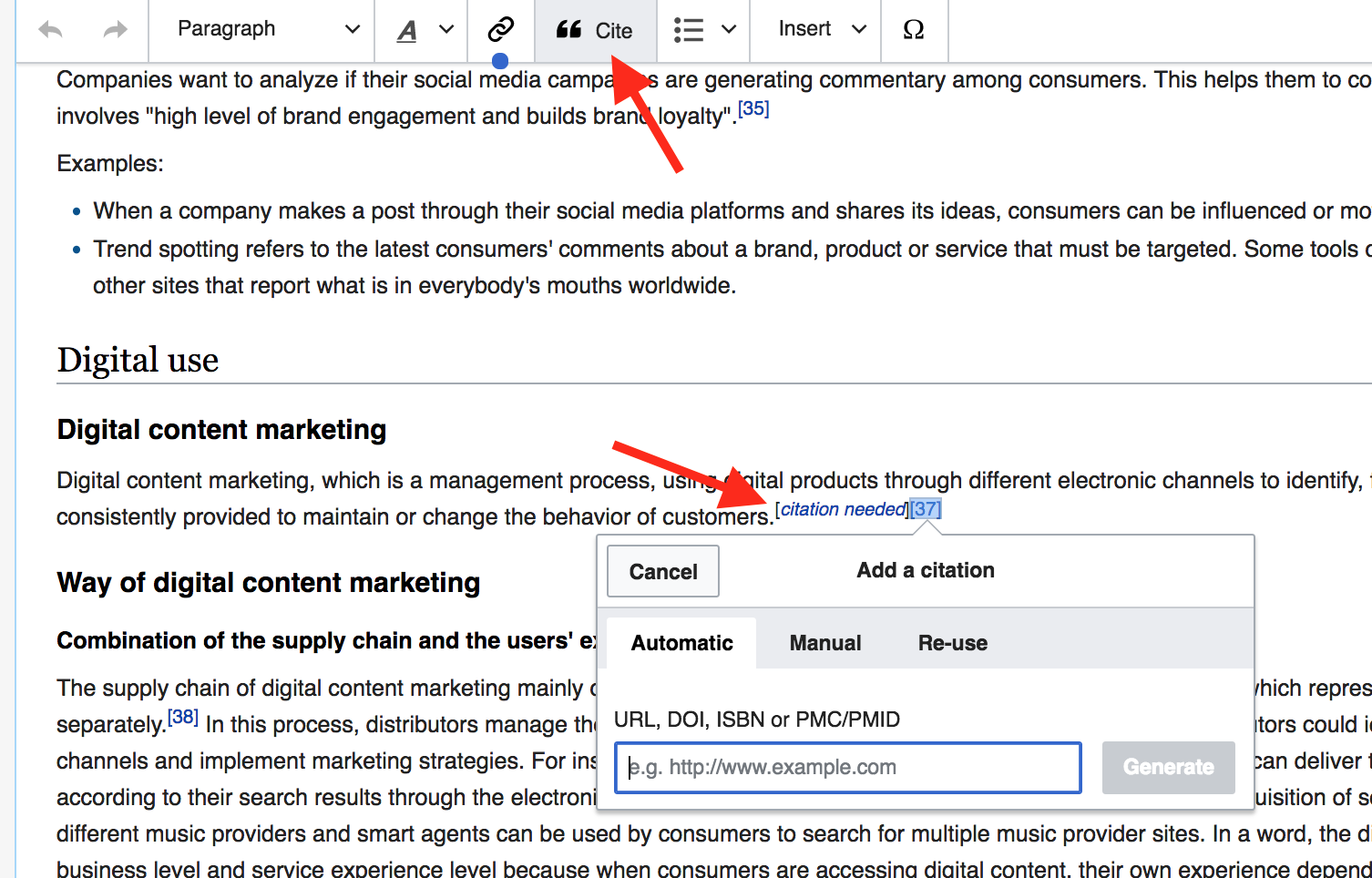
Paste your URL into the box above and click Generate.
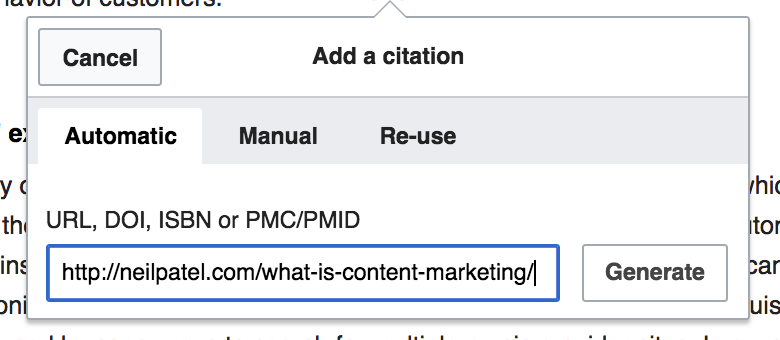
You’ll see this screen confirming your citation and marking the date it was added.
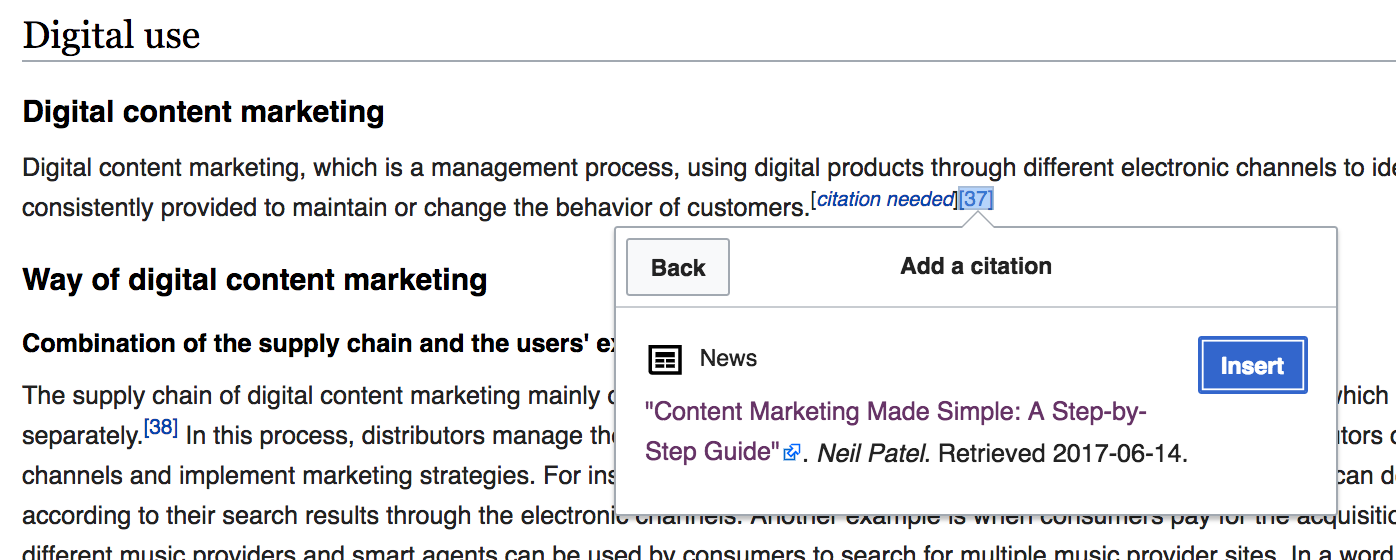
To save your changes to the article, click on Save Changes at the top right of your screen.
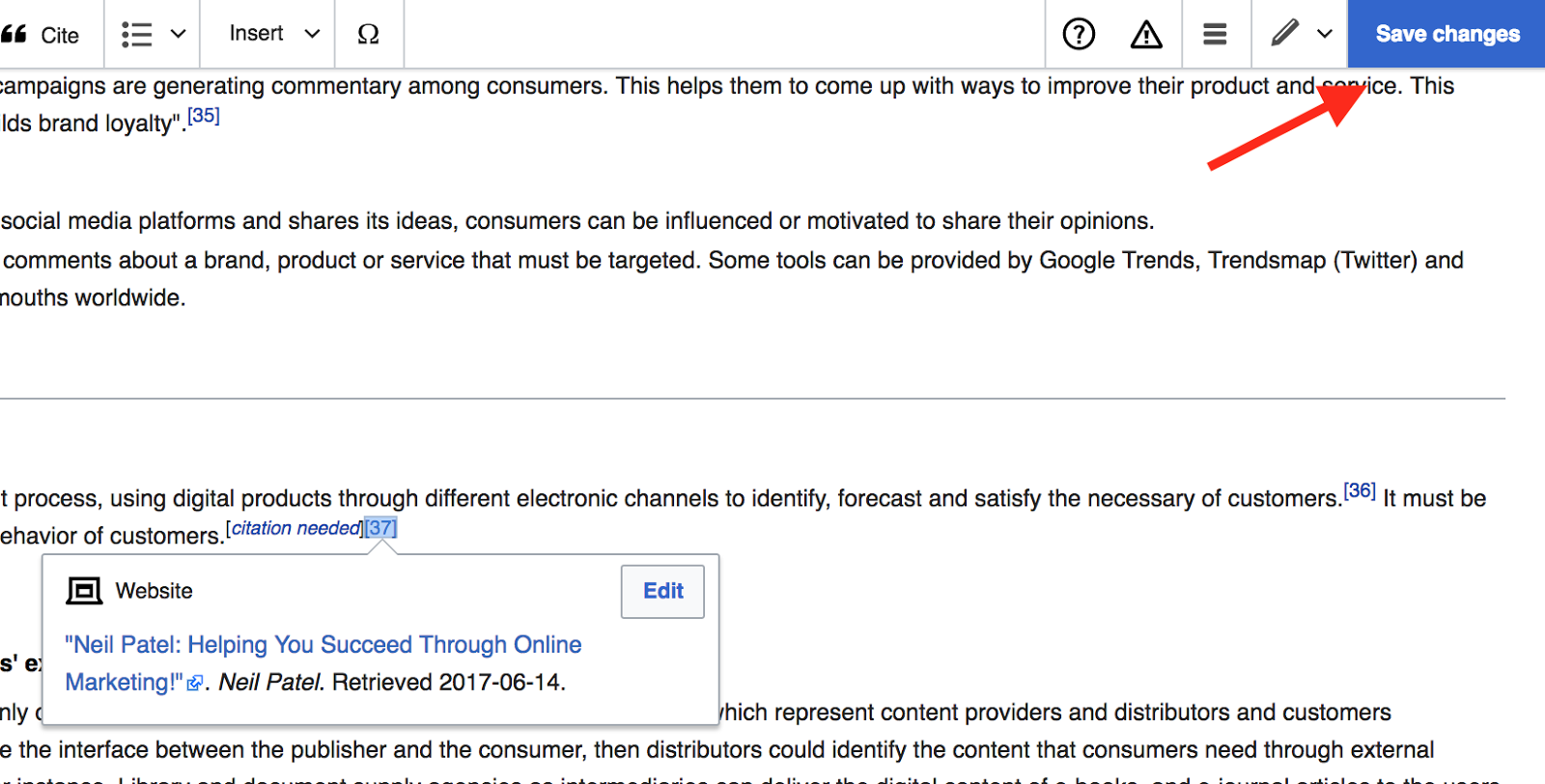
Your edit will be submitted for moderation. If Wikipedia staff agrees it’s a valid source of data for that point, it will be added to the page and you’ll enjoy increased page authority and traffic from Wikipedia.
Wikipedia links are technically no-follow, which means that they do not pass link juice over to you. However, their domain authority ranking and trust level from Google are very high, so there are still SEO benefits to snagging them!
Advanced SEO Tip 14. Find and Use Competitors’ SEO Keywords
Competitor research is a smart move. Why reinvent the wheel, when all of the hard work of ranking in Google’s top pages has already been done by your competitors?
You can spy on the exact keywords that they’re ranking for and use those same keywords to create better content.
Something as simple as signing up for your competitor’s newsletter can reveal their whole email marketing strategy to you. A little research doesn’t cost anything but your time, and can produce some great new strategies for you to try.
Starbucks made a big splash in China when they studied their competitors’ marketing. Spying helps you improve your own plans to beat the competition based on data, instead of assumptions.
Starbucks’ profit in China has been steadily increasing because they did some simple research.
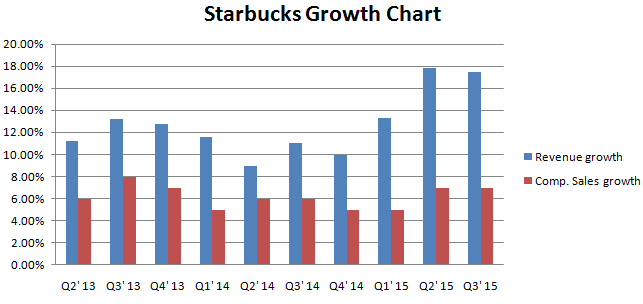
So how do you find out what keywords your competitors are ranking for right now?
Step #1: Head Over to Ubersuggest
Enter your competitor’s site URL into the search box and press Enter.
Step #2: Click Keyword Ideas in the Left Sidebar
This will give you a list of keywords related to your website.
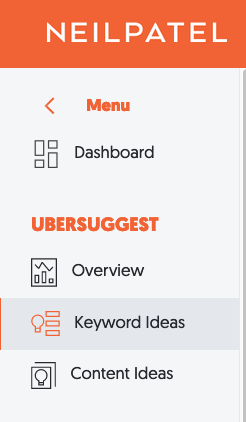
Step #3: Look at SEO Keywords
Scroll down to the last section titled SEO Keywords.
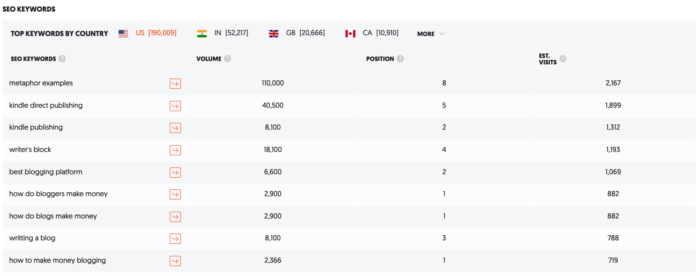
The Position column tells you which Google search result position your site sits in for that keyword. For example, smartblogger.com is in the first organic spot for “how do blogs make money”.
In order to verify whether the keywords are truly ranking at the positions Ubersuggest says, let’s do a quick Google search for “how do blogs make money”.
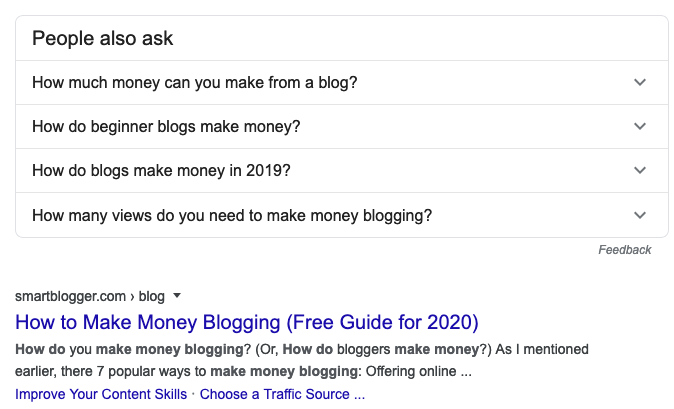
Definitely the top spot!
Now your job is to create high quality content using those same keywords. Use all the other tools in this list to build trusted links and boost that page’s ranking power.
If you want to get even more ideas for long-tail keywords to rank highly for, head back to the Ubersuggest home page.
- Step #1: Enter Your Head Keyword and Click Search
- Step #2: Click Keyword Ideas in the Left Sidebar
- Step #3: Review the Keyword Ideas
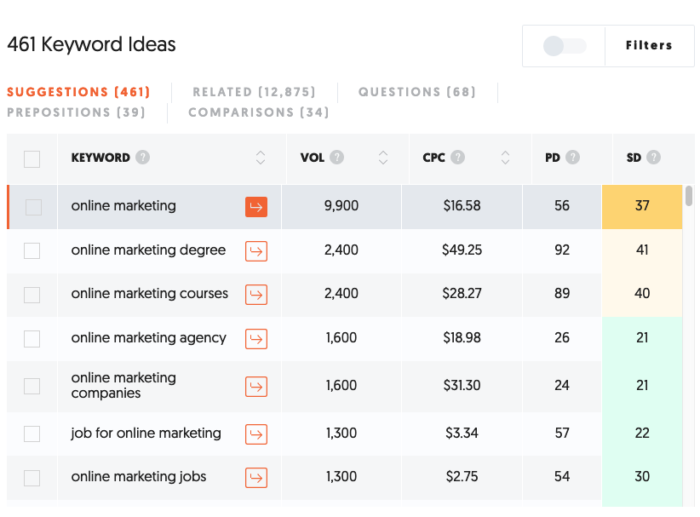
In this example, you’re provided 461 keywords related to “online marketing.” You can now use filters to find long-tail keywords with high volume and a low SEO Difficulty score.
For this search, I set the volume at 800 to 4,000 and the SD at 40 or below.
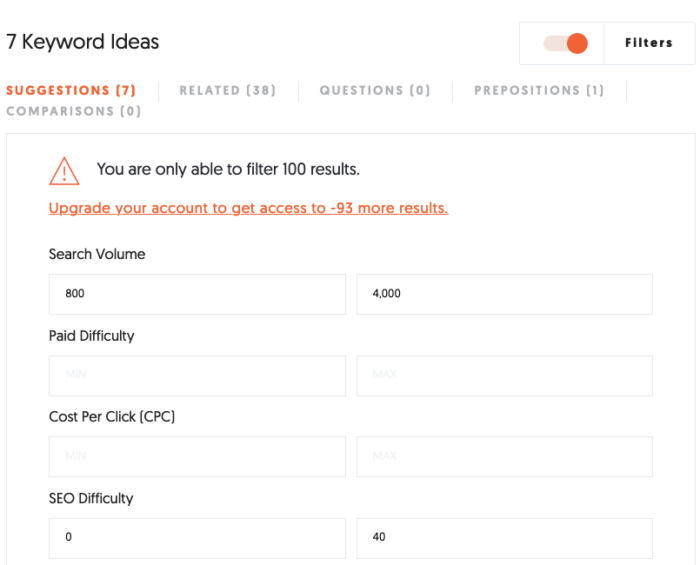
While these search parameters eliminated more than 350 keywords, it also left behind seven ideas to include in future content.
You know the monthly search volume is greater than 800 and the SD is lower than 40. With that, you can confidently optimize for the keyword, knowing that the first page of Google is within reach. When that happens, there’s traffic to be had.
After clicking on a keyword that piques your interest, you’ll see how your competition is doing:
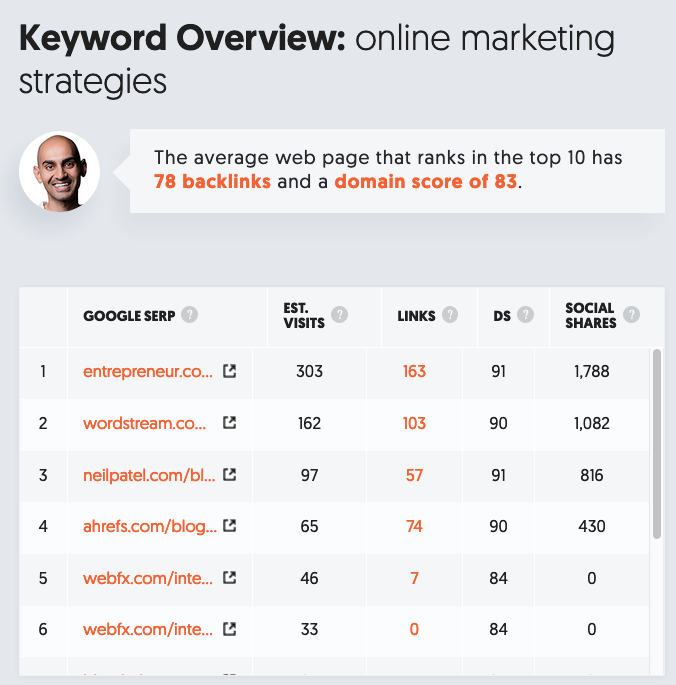
You’re given the following:
- URL for each page in the top 10 of the Google search results
- Estimated number of visits
- Number of backlinks
- Domain score
- Number of social shares
For the keyword “online marketing strategies,” my website is currently in the third position of the Google search results. This is good for roughly 97 visitors per month. However, if I am able to reach the top spot, I’ll pick up another 200+ visitors per month.
The data shows my domain score is in line with the top two search results, but the page doesn’t have nearly as many links or social shares. So, focusing on those two metrics will help me reach the goal of claiming the top search result.
Advanced SEO Tip 15. Use AdWords Copy in Your On-Page SEO
Another great way to steal the spotlight from your competition is to look for keyword ideas in their Google AdWords search ads.
Google AdWords ads are short and already optimized for your competition’s target keywords. If you can produce a quality article that ranks well organically for that same keyword, you can easily establish yourself among your target customers.
With 26 percent of internet users using ad blockers, consumers are warier than ever of paid advertising.
Establishing yourself high in organic search results establishes trust and will display you first to those using ad blockers.
To find some good AdWords keywords to create content around, try searching for keywords you want to rank for:

Analyze the titles and copy used in each of these ads. They should give you at least a few ideas for headlines you can use in new content.
A few from this example could be:
- How to Perform a Free SEO Website Audit
- How to Generate More Calls, Leads and Sales with Local SEO
- Increase Your Website’s Domain Authority in 30 Days
I wrote the first post below for QuickSprout using “How to Perform an SEO Audit”, and included the word free in the title.
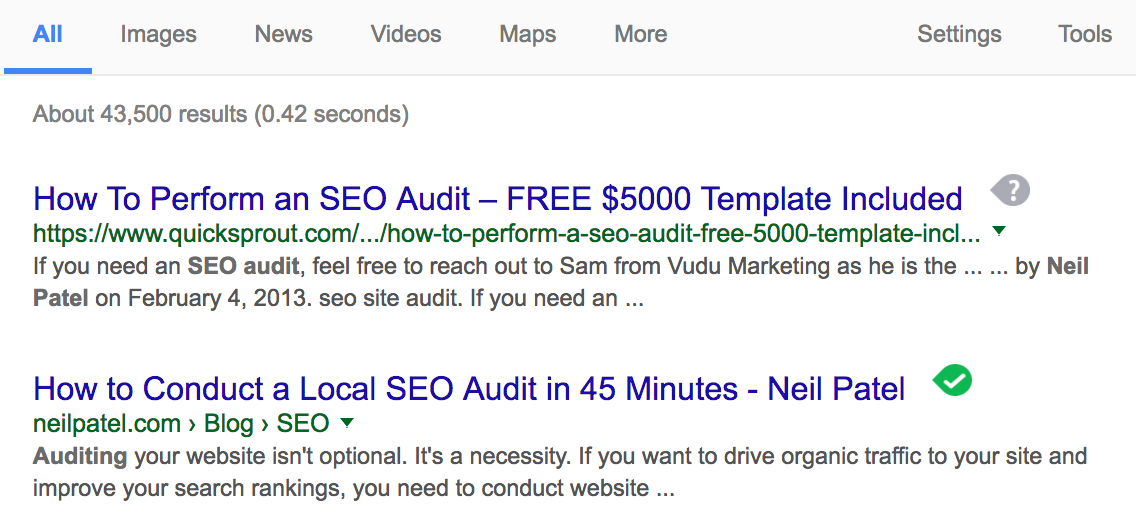
In that post, I broke down all the steps to do a full SEO website audit and included a template for users to download.
It remains a very popular post and still converts at over 50%. All for free, with no paid AdWords ads!
Advanced SEO Tip 16. Use Multiple Keywords in SEO Page Titles
Your SEO page title is the title that is displayed in Google search results. Here’s an example.
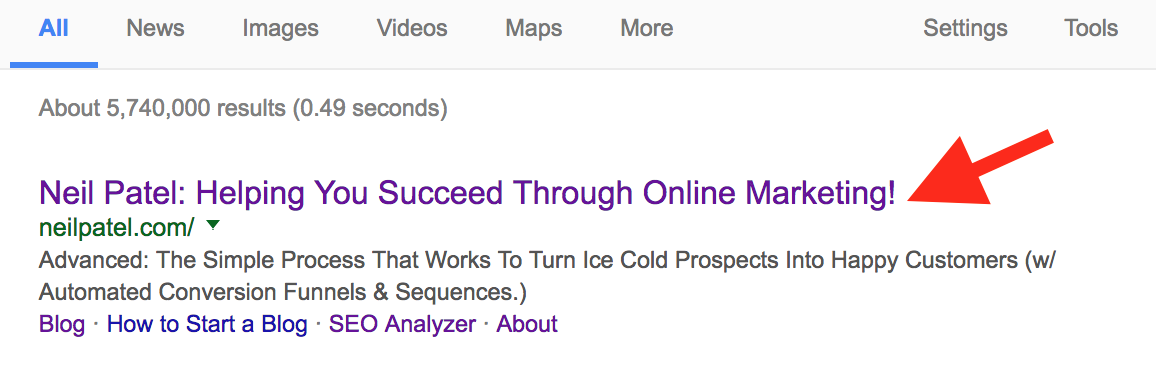
You want to ensure that each page title for each page and post on your website contains a keyword.
A strategy I have found particularly effective is to include multiple keywords within each page title. Make sure not to be spammy with this or it could end up hurting you.
By spammy, I mean just cramming keywords in there for the sake of it, even if they sound a little off. Or, by using spam trigger words that instantly make Google think your content is less than legit.
Let’s say your post is about hair colors for fall and you want to rank for the following keywords:
- Hair colour
- Autumn hair
- Autumn hair trends
Here are a few examples of a page title that combines those in a natural-sounding way:
- Autumn Hair Trends: The Best Hair Colors of the Season
- 5 Hot Hair Colours Right Now: Autumn Hair Trends
- And here’s an example of a keyword-stuffed, not good page title:
- Autumn Hair Colour Trends – Hair Colour for Autumn
See the difference? The first two sound natural and like you could picture seeing them online. The last one just seems spammy and like it’s trying too hard.
If your page titles sound like you’re trying too hard, you probably are.
Advanced SEO Tip 17. Monitor Google Search Console Stats
Google Search Console is a powerful tool to help you track potential issues with your site that affect your rankings.
If you haven’t already signed up for it, you can see how to do that step by step right here.
There are three main things you want to check regularly in Search Console:
- Watching for crawl errors, like 404 pages
- Submitting new sitemaps
- See which keywords people are using to find you
When you first sign in to Search Console, you’ll see your Dashboard page.
Under “Coverage,” you’ll see any URL erros.
As you can see, I have seven recent URL errors for my blog.

I had corrected a lot of 404 page errors in previous months that were caused by a switch to a new webhost, as you can tell by the red line. It’s important to keep monitoring these reports often as new errors can pop up anytime, like these seven have!
If you click on one of the URLs in the list, you’ll see this message.
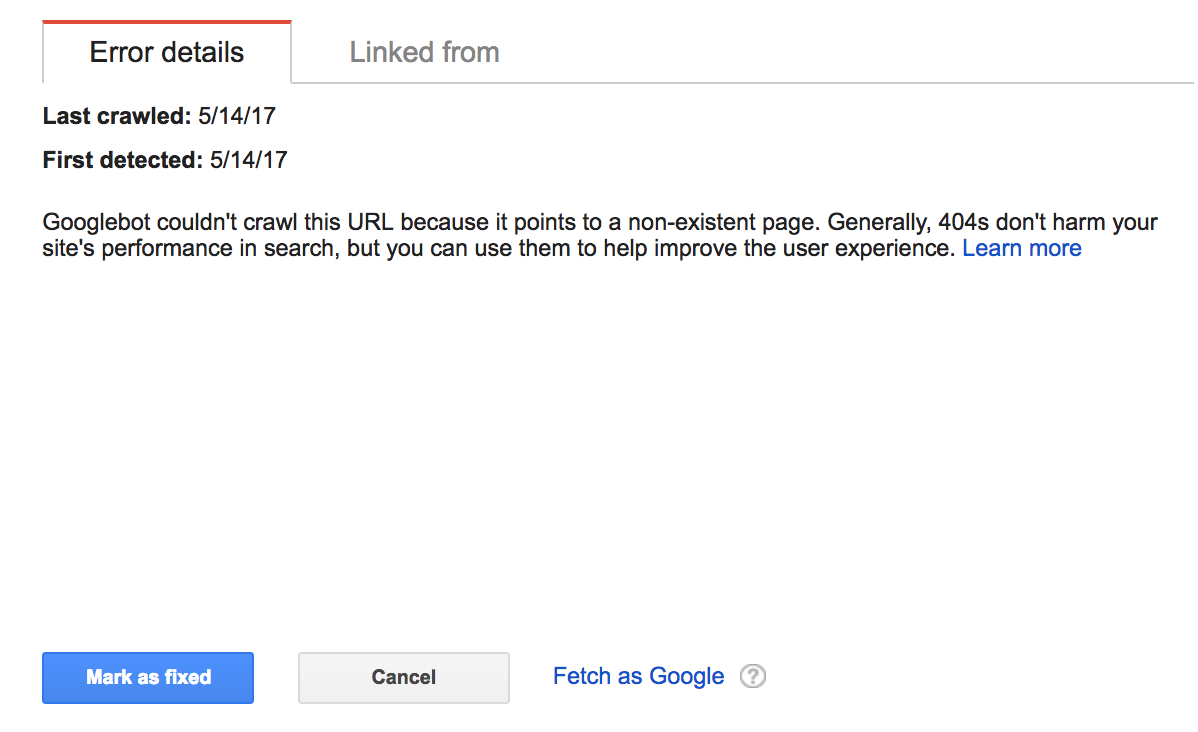
404 errors don’t have a direct impact your search result rankings, but they don’t make for a great user experience which can impact SEO.
You don’t want to show up high in search, get someone excited to visit your site, then disappoint them with a 404 page when they get there, right?
Fortunately, they’re very easy to correct in Search Console. For each 404 error, click on Fetch as Google in the screenshot above.
Search Console will tell you the result of what Google’s indexing spider sees.

In this case, my 404 page was showing up that way because it’s being redirected to a new page. This can be easily solved by getting my site re-indexed. Click on Request Indexing button, and you’re done.
There’s also an easier way: you can submit a new sitemap for your full site.
Click on Sitemaps on the left-side menu.

Enter in the URL to your sitemap. For most people, this is just “sitemap.xml” after your domain name, like neilpatel.com/sitemap.xml.
If you need help creating a sitemap, use this guide on How to Create an SEO-Boosting XML Sitemap in 20 Minutes (or Less.)
When you submit a new sitemap, the status changes to Pending.

Getting Google to re-index your site will ensure any 404 errors that you know don’t exist are marked as fixed.
Another great use of Search Console is to find out the keywords people are using to find you.
Click on Performance in the left-side menu.
You’ll see a list of keywords that people typed into Google that displayed your website, whether they clicked on your page or not.
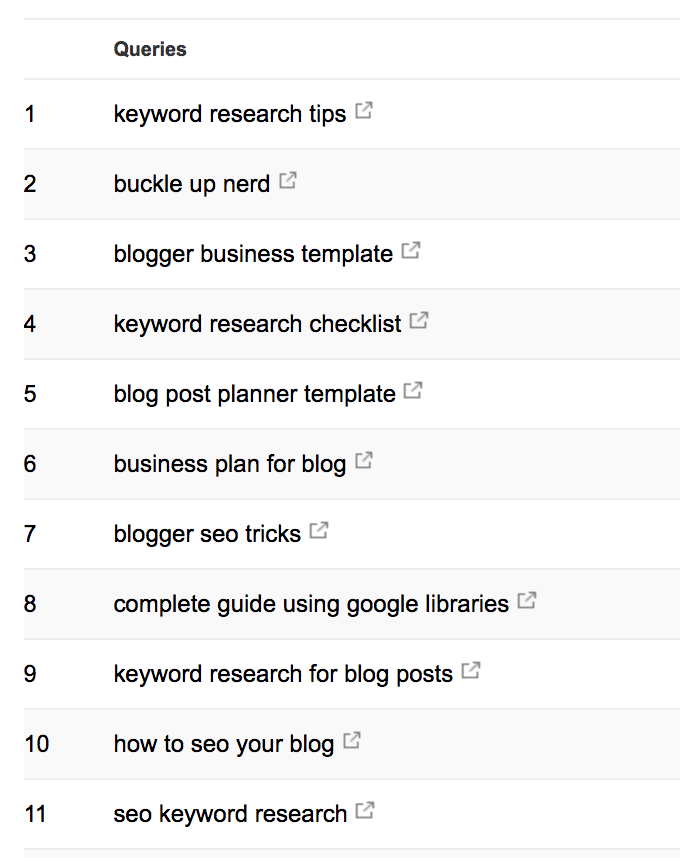
Looking at how people found you can tell you a lot about what you’re ranking well for. If the keywords in your list aren’t the ones you want to rank for, it’s time to optimize more of your content!
Advanced SEO Tip 18. Update Old Content
If you’ve been blogging for more than three months, you’ve got a goldmine of content in your archives to repurpose.
You’ve undoubtedly written some posts that are still generating organic traffic. You can improve those posts and leverage their authority for higher search rankings.
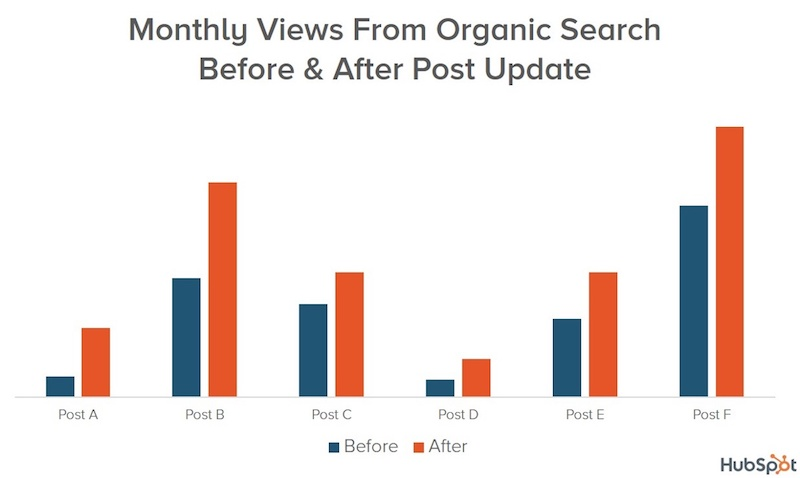
Start by making a list of your top performing content.
Step #1: Find Posts That Need Some Love
Log into Google Analytics. Click the “Behavior” tab on the left side.
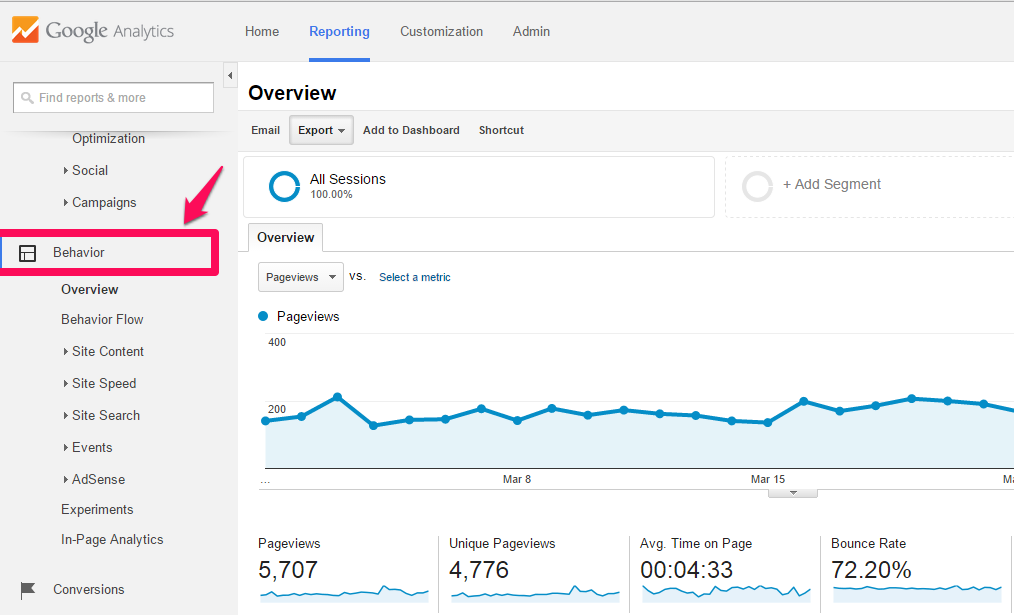
Step #2: Click Site Content -> All Pages
Look for the best performing posts from three to six months ago. These posts are doing well, but a refresh could drive even more traffic.
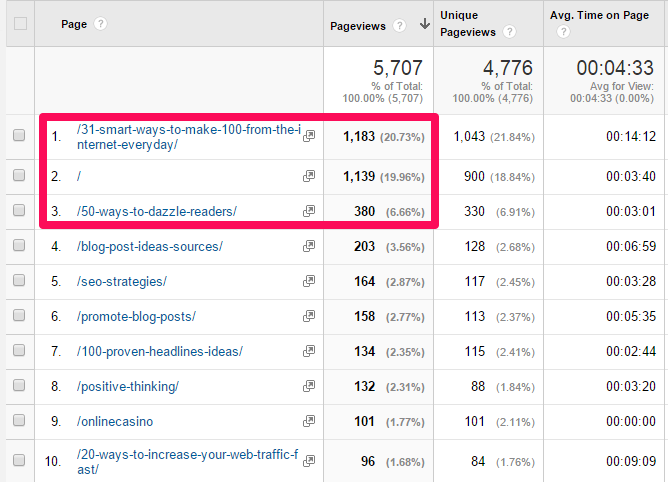
Step 4: Update Old Posts
Here’s what I do to update my best performing posts to keep them fresh and popular:
Write a Sharable Headline
The most critical step of all is to write a headline that will inspire people to share your post, and that contains your SEO keyword.
So, if your old post was titled “How to Make $10,000 From Your Blog,” you could make it more sharable by adding a bit of personal flair. The headline should evoke curiosity, but still maintain its clarity.
Something like this: How I Make $10,000 a Month From My Blog While Traveling the World
That’s a bit more fun, huh?
You could even add a number to the headline, as people more frequently share headlines that contain a number. Headlines like, “7 Reasons Why Blogging Can Be a Career”, etc.

For example:
- How I Make $10,000 Blogging Part Time (and 3-Step Plan You Can Follow)
- How I Made My First $10,000 Blogging From Home in 30 Days
Take a look at this Copy Hackers headline. It’s thought-provoking, keyword-rich, clickable and clear:
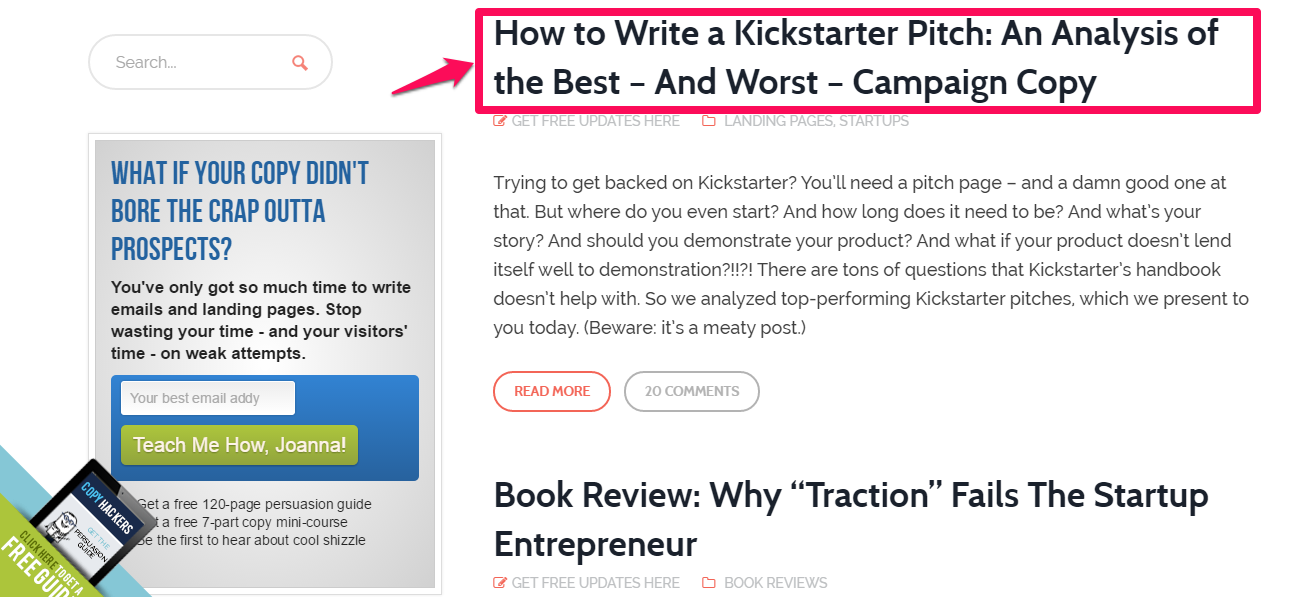
Add Customer Testimonials or Notable Mentions
Now that you have some experience, let it show in your content.
Customer testimonials are huge for marketing. When it comes to including a testimonial within a piece of content, that content has an 89% success rate.
Your reader may not jump on board if you’re the only one saying how awesome you are. But if someone else backs it up, your authority and influence will increase.
When you get a testimonial, find a piece of content that fits it and include that testimonial.
Update Old Data and Images
If your post was originally from 2014, you clearly need to update your data sources.
If your website has gone through a redesign during that time, you’ll likely need to update images in the post to be in line with your current branding.
I do this regularly with my best performing content. For example, this guide on getting your website indexed is one of my most popular posts.
Whenever something changes with Google’s algorithm or indexing rules, I update that post so it’s always up to date. I don’t want new users coming to my site and finding outdated info, so it’s important that my top content is accurate.
Another word for content like this is your ‘cornerstone content’.
Cornerstone content is basically the foundation of your blog. They are the articles you are most proud of and the ones that are the most unique, in-depth and informative.
Brian Clark describes it as, “It’s what people need to know to make use of your website and do business with you.”
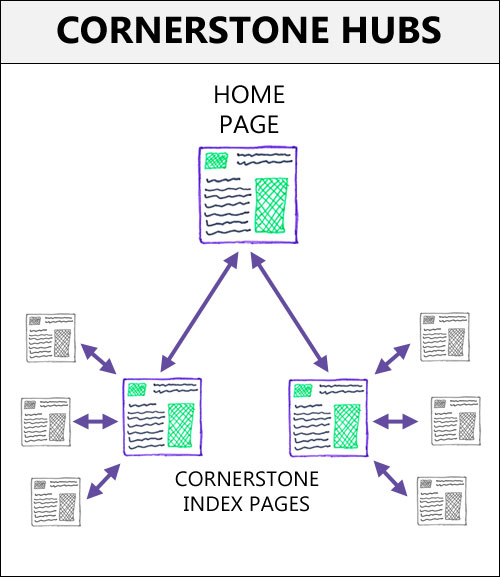
An easy way to keep track of your cornerstone content is to create a spreadsheet. Add the following columns:
- Post title
- Post URL
- Topic
- Main keywords
- Last Updated
Scan through your list every few months and ensure that none of these posts go too long without being updated. Don’t go more than six months without updating one of your cornerstone pieces.
Advanced SEO Tip 19. BONUS – Revamp Old Articles With More Organic Traffic Potential
In the previous section, we covered how you can keep your best performing articles fresh and optimized. But what about the articles that didn’t go over so well?
You should also be updating your lowest performing content to improve it.
You know it’s a good topic and that people want to know about it, otherwise you wouldn’t have written about it in the first place. Revamping an old underperforming article is a sure way to get more organic search traffic.
What’s the alternative? Writing a new post from scratch. It may do well, or it could flop too. It’s worth the effort to revamp an old post!
Here’s how to turn your previous content failures into organic search stars:
Make a List of Underperforming Content
Open up Google Analytics and click on Behavior > Site Content > All Pages.
Look at page views, average time on page, and bounce rate.
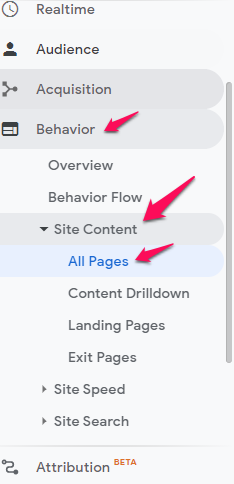
If you click on the arrow next to Pageviews, you can see the pages with the least amount of traffic. These are pages that need some thelp!
Analyze Keywords
For each of your lowest performing posts that you want to update, run them through whatsmyserp.
Enter the keyword you want to check the ranking of and your post’s URL, and click Go.
You can enter in multiple searches one at a time and see all your results at the bottom of the page.
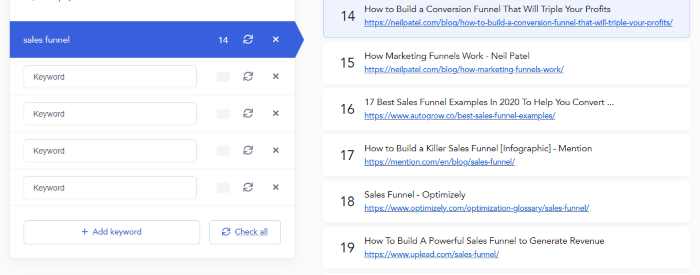
This post ranked 14 for sales funnel — which might isn’t even on the first page.
If my goal were to rank higher for ‘sales funnel’, I now have some data to start with. There are over 200 factors that go into search engine rankings, but updating this old post with better optimization for that keyword will help boost its position.
The top four organic search results get 69.6% of all traffic.
The higher you can get underperforming content to rank in search results, the more eyeballs will be on it, and the more clicks you’ll get.
Update the Post
Similar to the section above, you’ll want to update:
- Old data or citations
- Images or broken links
- Optimize for keywords you want to rank higher for
- Add new insights from your experience, or recent news that’s relevant
- Add a testimonial or case study
I recently went through this process with this post about starting a blog.
Before I updated it, it was ranking on page three. After expanding the post to over 3,000 words, updating all the images and screenshots, adding new information and resharing it to my network, the post is now on page one for “how to start a blog”.
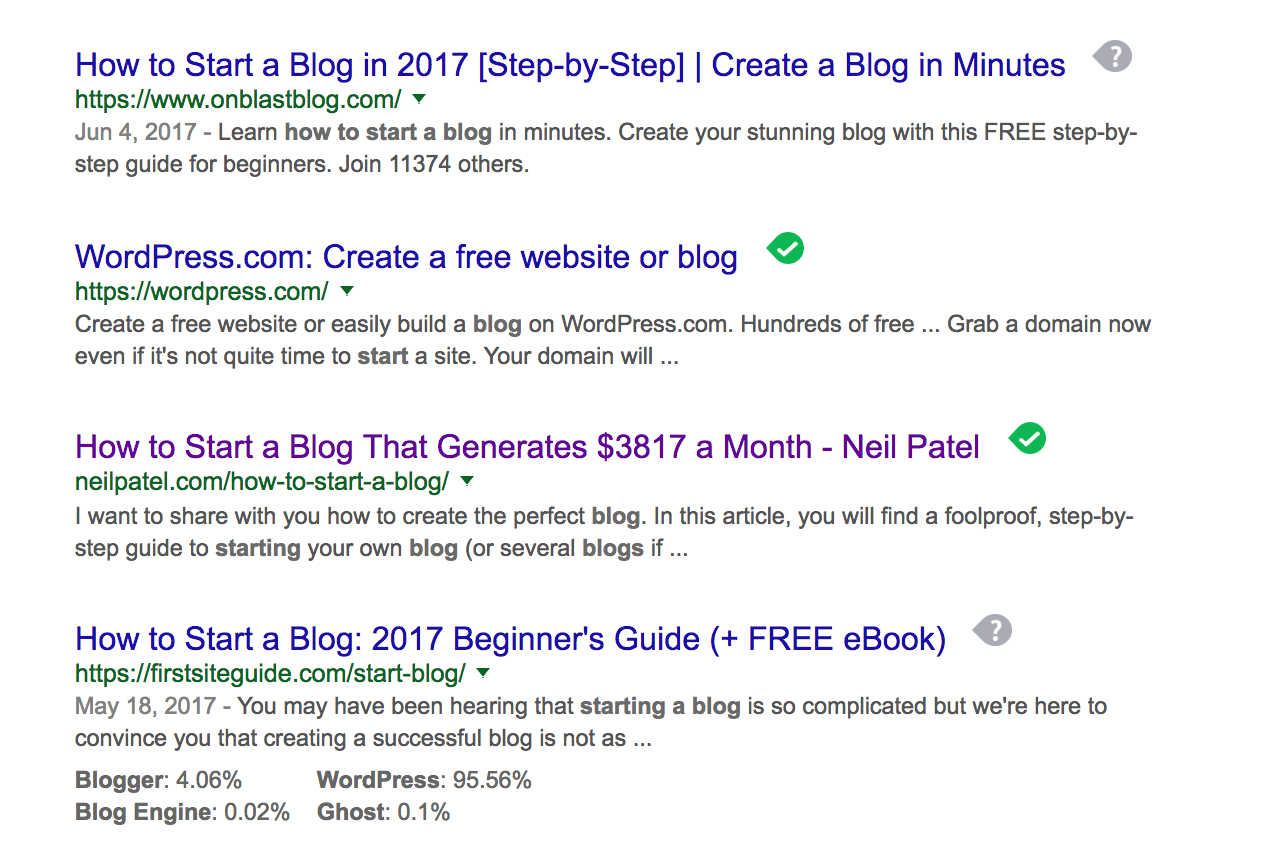
The post has received a 167% jump in traffic since I revamped it and it’s now my second most shared post ever!
Relaunch the Post
You can’t just press update and expect the world to know you just added a ton more value to your old post. You need to tell people.
It’s important to edit the publish date of the post to today’s date. You don’t want it to get buried in your archives, or for Google to think it’s old news.
When you’re ready to relaunch the post, change the publish date. In WordPress, there’s an edit link next to the date you can click.
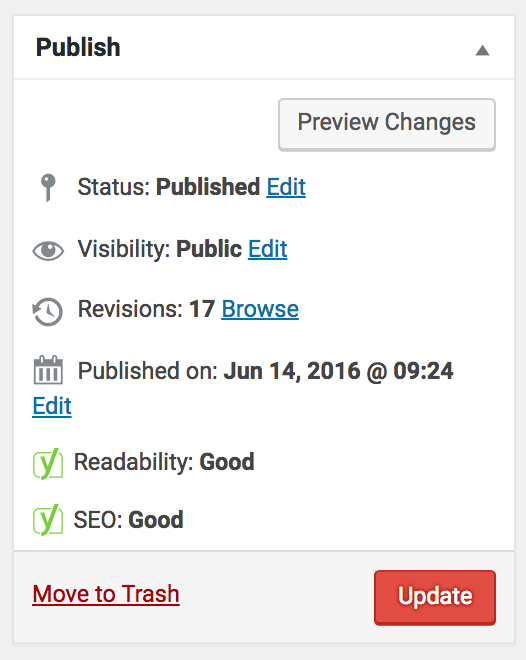
Just change that to the current date.
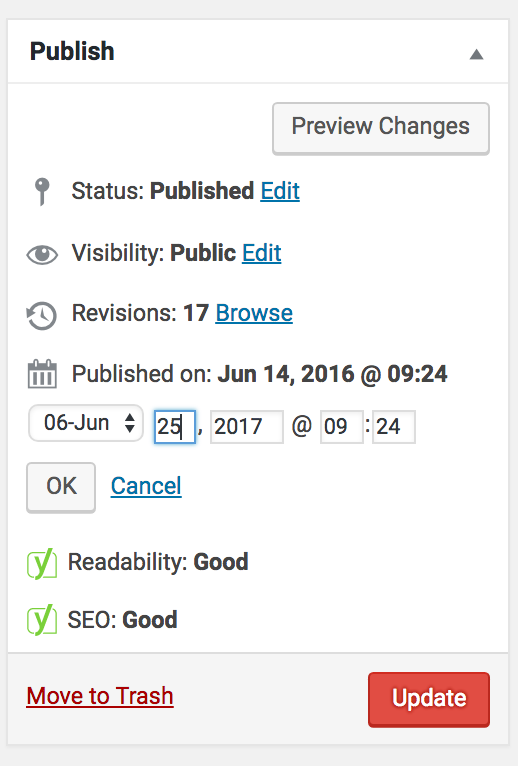
This makes your revamped post show at the top of your blog feed so it looks brand new and more people see it.
There are a few more things you’ll want to do right away:
- Share it on social media
- Contact anyone mentioned in the revamped content and ask them to share it out too (this is very effective!)
- Send it out to your email list
Revamping old content has been really successful for me.
It would have taken me 10x as long to come up with all new post ideas and write them instead of editing the ones I already had. Making use of existing content is always more efficient than starting from scratch and the traffic results prove it.
Conclusion
A blog is a powerful brand marketing tool.
Maybe that’s because, by their very nature, blogs provide a personal touch that’s not found elsewhere.
In order to maximize your blog’s potential, you have to make sure it gets found in search results.
These advanced SEO techniques may not be the easiest to implement – they certainly require more effort than basic keyword research and link building – but they are incredibly effective. Using these strategies can double your search traffic.
Remember the human beings on the other side of the screen and write for what they want to read. Focusing on user intent and trying out these 19 advanced SEO tips is a recipe for traffic success.
Have you tried any of these advanced SEO techniques before? What results did you get and how long did it take to see them?
The post 19 Advanced SEO Techniques to Double Your Search Traffic appeared first on Neil Patel.
About us and this blog
We are a digital marketing company with a focus on helping our customers achieve great results across several key areas.
Request a free quote
We offer professional SEO services that help websites increase their organic search score drastically in order to compete for the highest rankings even when it comes to highly competitive keywords.
Subscribe to our newsletter!
More from our blog
See all postsRecent Posts
- Web Hosting September 26, 2023
- Affiliate Management September 26, 2023
- Online Presence Analysis September 26, 2023

